
ruby-nano-bots
Ruby Implementation of Nano Bots: small, AI-powered bots that can be easily shared as a single file, designed to support multiple providers such as Cohere Command, Google Gemini, Maritaca AI MariTalk, Mistral AI, Ollama, OpenAI ChatGPT, and others, with support for calling tools (functions).
Stars: 76
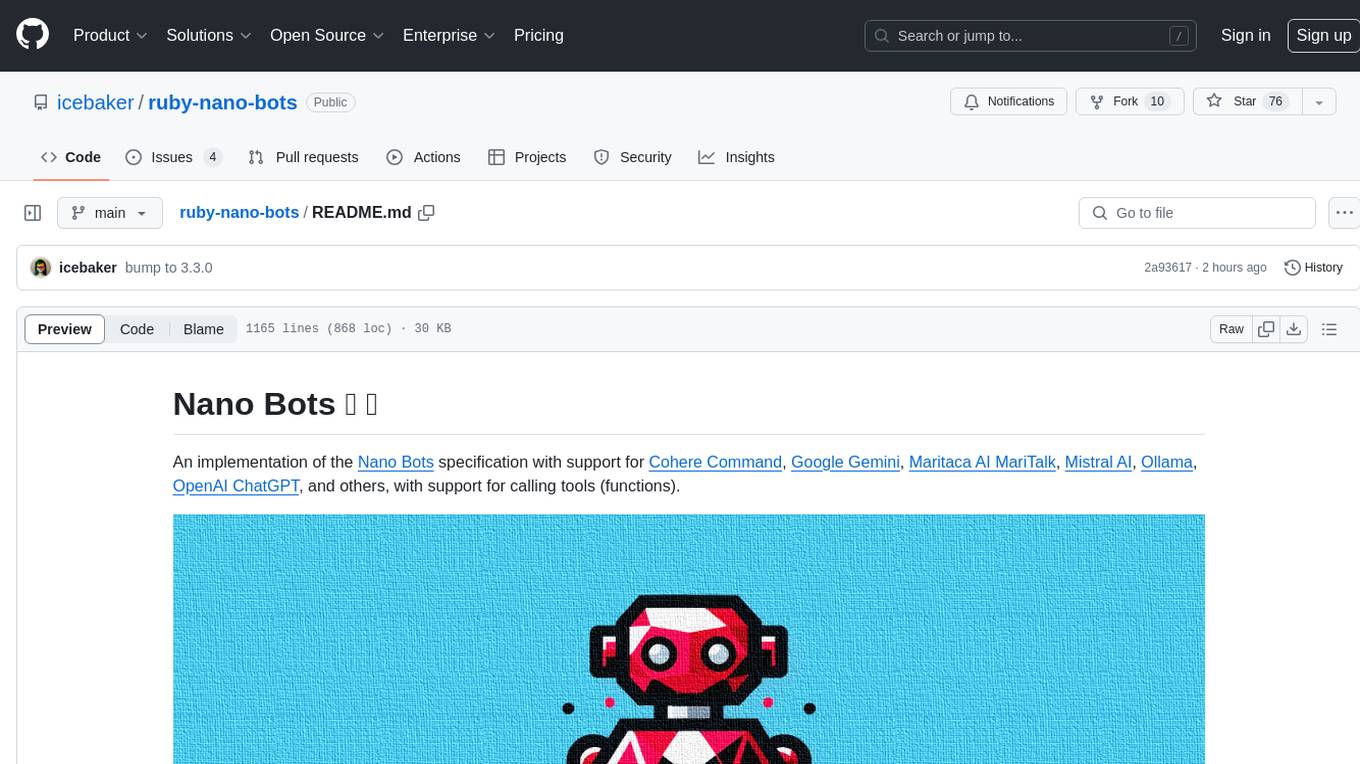
Ruby Nano Bots is an implementation of the Nano Bots specification supporting various AI providers like Cohere Command, Google Gemini, Maritaca AI MariTalk, Mistral AI, Ollama, OpenAI ChatGPT, and others. It allows calling tools (functions) and provides a helpful assistant for interacting with AI language models. The tool can be used both from the command line and as a library in Ruby projects, offering features like REPL, debugging, and encryption for data privacy.
README:
An implementation of the Nano Bots specification with support for Cohere Command, Google Gemini, Maritaca AI MariTalk, Mistral AI, Ollama, OpenAI ChatGPT, and others, with support for calling tools (functions).
gem install nano-bots -v 3.1.0nb - - eval "hello"
# => Hello! How may I assist you today?nb - - repl🤖> Hi, how are you doing?
As an AI language model, I do not experience emotions but I am functioning
well. How can I assist you?
🤖> |
---
meta:
symbol: 🤖
name: Nano Bot Name
author: Your Name
version: 1.0.0
license: CC0-1.0
description: A helpful assistant.
behaviors:
interaction:
directive: You are a helpful assistant.
provider:
id: openai
credentials:
access-token: ENV/OPENAI_API_KEY
settings:
user: ENV/NANO_BOTS_END_USER
model: gpt-4onb gpt.yml - eval "hi"
# => Hello! How can I assist you today?gem 'nano-bots', '~> 3.1.0'require 'nano-bots'
bot = NanoBot.new(cartridge: 'gpt.yml')
bot.eval('Hi!') do |content, fragment, finished, meta|
print fragment unless fragment.nil?
end
# => Hello! How can I assist you today?- TL;DR and Quick Start
- Usage
- Setup
- Cartridges
- Security and Privacy
- Supported Providers
- Docker
- Development
After installing the gem, the nb binary command will be available for your project or system.
Examples of usage:
nb - - eval "hello"
# => Hello! How may I assist you today?
nb to-en-us-translator.yml - eval "Salut, comment ça va?"
# => Hello, how are you doing?
nb midjourney.yml - eval "happy cyberpunk robot"
# => A cheerful and fun-loving robot is dancing wildly amidst a
# futuristic and lively cityscape. Holographic advertisements
# and vibrant neon colors can be seen in the background.
nb lisp.yml - eval "(+ 1 2)"
# => 3
cat article.txt |
nb to-en-us-translator.yml - eval |
nb summarizer.yml - eval
# -> LLM stands for Large Language Model, which refers to an
# artificial intelligence algorithm capable of processing
# and understanding vast amounts of natural language data,
# allowing it to generate human-like responses and perform
# a range of language-related tasks.nb - - repl
nb assistant.yml - repl🤖> Hi, how are you doing?
As an AI language model, I do not experience emotions but I am functioning
well. How can I assist you?
🤖> |
You can exit the REPL by typing exit.
All of the commands above are stateless. If you want to preserve the history of your interactions, replace the - with a state key:
nb assistant.yml your-user eval "Salut, comment ça va?"
nb assistant.yml your-user repl
nb assistant.yml 6ea6c43c42a1c076b1e3c36fa349ac2c eval "Salut, comment ça va?"
nb assistant.yml 6ea6c43c42a1c076b1e3c36fa349ac2c replYou can use a simple key, such as your username, or a randomly generated one:
require 'securerandom'
SecureRandom.hex # => 6ea6c43c42a1c076b1e3c36fa349ac2cnb - - cartridge
nb cartridge.yml - cartridge
nb - STATE-KEY state
nb cartridge.yml STATE-KEY stateTo use it as a library:
require 'nano-bots/cli' # Equivalent to the `nb` command.require 'nano-bots'
NanoBot.cli # Equivalent to the `nb` command.
NanoBot.repl(cartridge: 'cartridge.yml') # Starts a new REPL.
bot = NanoBot.new(cartridge: 'cartridge.yml')
bot = NanoBot.new(
cartridge: YAML.safe_load(File.read('cartridge.yml'), permitted_classes: [Symbol])
)
bot = NanoBot.new(
cartridge: { ... } # Parsed Cartridge Hash
)
bot.eval('Hello')
bot.eval('Hello', as: 'eval')
bot.eval('Hello', as: 'repl')
# When stream is enabled and available:
bot.eval('Hi!') do |content, fragment, finished, meta|
print fragment unless fragment.nil?
end
bot.repl # Starts a new REPL.
NanoBot.repl(cartridge: 'cartridge.yml', state: '6ea6c43c42a1c076b1e3c36fa349ac2c')
bot = NanoBot.new(cartridge: 'cartridge.yml', state: '6ea6c43c42a1c076b1e3c36fa349ac2c')
bot.prompt # => "🤖\u001b[34m> \u001b[0m"
bot.boot
bot.boot(as: 'eval')
bot.boot(as: 'repl')
bot.boot do |content, fragment, finished, meta|
print fragment unless fragment.nil?
endTo install the CLI on your system:
gem install nano-bots -v 3.1.0To use it in a Ruby project as a library, add to your Gemfile:
gem 'nano-bots', '~> 3.1.0'bundle installFor credentials and configurations, relevant environment variables can be set in your .bashrc, .zshrc, or equivalent files, as well as in your Docker Container or System Environment. Example:
export NANO_BOTS_ENCRYPTION_PASSWORD=UNSAFE
export NANO_BOTS_END_USER=your-user
# export NANO_BOTS_STATE_PATH=/home/user/.local/state/nano-bots
# export NANO_BOTS_CARTRIDGES_PATH=/home/user/.local/share/nano-bots/cartridgesAlternatively, if your current directory has a .env file with the environment variables, they will be automatically loaded:
NANO_BOTS_ENCRYPTION_PASSWORD=UNSAFE
NANO_BOTS_END_USER=your-user
# NANO_BOTS_STATE_PATH=/home/user/.local/state/nano-bots
# NANO_BOTS_CARTRIDGES_PATH=/home/user/.local/share/nano-bots/cartridgesYou can obtain your credentials on the Cohere Platform.
export COHERE_API_KEY=your-api-keyAlternatively, if your current directory has a .env file with the environment variables, they will be automatically loaded:
COHERE_API_KEY=your-api-keyCreate a cartridge.yml file:
---
meta:
symbol: 🤖
name: Nano Bot Name
author: Your Name
version: 1.0.0
license: CC0-1.0
description: A helpful assistant.
behaviors:
interaction:
directive: You are a helpful assistant.
provider:
id: cohere
credentials:
api-key: ENV/COHERE_API_KEY
settings:
model: commandRead the full specification for Cohere Command.
nb cartridge.yml - eval "Hello"
nb cartridge.yml - replbot = NanoBot.new(cartridge: 'cartridge.yml')
puts bot.eval('Hello')You can obtain your API key at MariTalk.
Enclose credentials in single quotes when using environment variables to prevent issues with the $ character in the API key:
export MARITACA_API_KEY='123...$a12...'Alternatively, if your current directory has a .env file with the environment variables, they will be automatically loaded:
MARITACA_API_KEY='123...$a12...'Create a cartridge.yml file:
---
meta:
symbol: 🤖
name: Nano Bot Name
author: Your Name
version: 1.0.0
license: CC0-1.0
description: A helpful assistant.
behaviors:
interaction:
directive: You are a helpful assistant.
provider:
id: maritaca
credentials:
api-key: ENV/MARITACA_API_KEY
settings:
model: sabia-2-mediumRead the full specification for Mistral AI.
nb cartridge.yml - eval "Hello"
nb cartridge.yml - replbot = NanoBot.new(cartridge: 'cartridge.yml')
puts bot.eval('Hello')You can obtain your credentials on the Mistral Platform.
export MISTRAL_API_KEY=your-api-keyAlternatively, if your current directory has a .env file with the environment variables, they will be automatically loaded:
MISTRAL_API_KEY=your-api-keyCreate a cartridge.yml file:
---
meta:
symbol: 🤖
name: Nano Bot Name
author: Your Name
version: 1.0.0
license: CC0-1.0
description: A helpful assistant.
behaviors:
interaction:
directive: You are a helpful assistant.
provider:
id: mistral
credentials:
api-key: ENV/MISTRAL_API_KEY
settings:
model: mistral-medium-latestRead the full specification for Mistral AI.
nb cartridge.yml - eval "Hello"
nb cartridge.yml - replbot = NanoBot.new(cartridge: 'cartridge.yml')
puts bot.eval('Hello')To install and set up, follow the instructions on the Ollama website.
export OLLAMA_API_ADDRESS=http://localhost:11434Alternatively, if your current directory has a .env file with the environment variables, they will be automatically loaded:
OLLAMA_API_ADDRESS=http://localhost:11434Create a cartridge.yml file:
---
meta:
symbol: 🤖
name: Nano Bot Name
author: Your Name
version: 1.0.0
license: CC0-1.0
description: A helpful assistant.
behaviors:
interaction:
directive: You are a helpful assistant.
provider:
id: ollama
credentials:
address: ENV/OLLAMA_API_ADDRESS
settings:
model: llama3Read the full specification for Ollama.
nb cartridge.yml - eval "Hello"
nb cartridge.yml - replbot = NanoBot.new(cartridge: 'cartridge.yml')
puts bot.eval('Hello')You can obtain your credentials on the OpenAI Platform.
export OPENAI_API_KEY=your-access-tokenAlternatively, if your current directory has a .env file with the environment variables, they will be automatically loaded:
OPENAI_API_KEY=your-access-tokenCreate a cartridge.yml file:
---
meta:
symbol: 🤖
name: Nano Bot Name
author: Your Name
version: 1.0.0
license: CC0-1.0
description: A helpful assistant.
behaviors:
interaction:
directive: You are a helpful assistant.
provider:
id: openai
credentials:
access-token: ENV/OPENAI_API_KEY
settings:
user: ENV/NANO_BOTS_END_USER
model: gpt-4oRead the full specification for OpenAI ChatGPT.
nb cartridge.yml - eval "Hello"
nb cartridge.yml - replbot = NanoBot.new(cartridge: 'cartridge.yml')
puts bot.eval('Hello')Click here to learn how to obtain your credentials.
export GOOGLE_API_KEY=your-api-keyAlternatively, if your current directory has a .env file with the environment variables, they will be automatically loaded:
GOOGLE_API_KEY=your-api-keyCreate a cartridge.yml file:
---
meta:
symbol: 🤖
name: Nano Bot Name
author: Your Name
version: 1.0.0
license: CC0-1.0
description: A helpful assistant.
behaviors:
interaction:
directive: You are a helpful assistant.
provider:
id: google
credentials:
service: generative-language-api
api-key: ENV/GOOGLE_API_KEY
options:
model: gemini-proRead the full specification for Google Gemini.
nb cartridge.yml - eval "Hello"
nb cartridge.yml - replbot = NanoBot.new(cartridge: 'cartridge.yml')
puts bot.eval('Hello')export GOOGLE_CREDENTIALS_FILE_PATH=google-credentials.json
export GOOGLE_REGION=us-east4Alternatively, if your current directory has a .env file with the environment variables, they will be automatically loaded:
GOOGLE_CREDENTIALS_FILE_PATH=google-credentials.json
GOOGLE_REGION=us-east4Create a cartridge.yml file:
---
meta:
symbol: 🤖
name: Nano Bot Name
author: Your Name
version: 1.0.0
license: CC0-1.0
description: A helpful assistant.
behaviors:
interaction:
directive: You are a helpful assistant.
provider:
id: google
credentials:
service: vertex-ai-api
file-path: ENV/GOOGLE_CREDENTIALS_FILE_PATH
region: ENV/GOOGLE_REGION
options:
model: gemini-proRead the full specification for Google Gemini.
nb cartridge.yml - eval "Hello"
nb cartridge.yml - replbot = NanoBot.new(cartridge: 'cartridge.yml')
puts bot.eval('Hello')export GOOGLE_REGION=us-east4Alternatively, if your current directory has a .env file with the environment variables, they will be automatically loaded:
GOOGLE_REGION=us-east4Create a cartridge.yml file:
---
meta:
symbol: 🤖
name: Nano Bot Name
author: Your Name
version: 1.0.0
license: CC0-1.0
description: A helpful assistant.
behaviors:
interaction:
directive: You are a helpful assistant.
provider:
id: google
credentials:
service: vertex-ai-api
region: ENV/GOOGLE_REGION
options:
model: gemini-proRead the full specification for Google Gemini.
nb cartridge.yml - eval "Hello"
nb cartridge.yml - replbot = NanoBot.new(cartridge: 'cartridge.yml')
puts bot.eval('Hello')If you need to manually set a Google Project ID:
export GOOGLE_PROJECT_ID=your-project-idAlternatively, if your current directory has a .env file with the environment variables, they will be automatically loaded:
GOOGLE_PROJECT_ID=your-project-idAdd to your cartridge.yml file:
---
provider:
id: google
credentials:
project-id: ENV/GOOGLE_PROJECT_IDCheck the Nano Bots specification to learn more about how to build cartridges.
Try the Nano Bots Clinic (Live Editor) to learn about creating Cartridges.
Here's what a Nano Bot Cartridge looks like:
---
meta:
symbol: 🤖
name: Nano Bot Name
author: Your Name
version: 1.0.0
license: CC0-1.0
description: A helpful assistant.
behaviors:
interaction:
directive: You are a helpful assistant.
provider:
id: openai
credentials:
access-token: ENV/OPENAI_API_KEY
settings:
user: ENV/NANO_BOTS_END_USER
model: gpt-4oNano Bots can also be powered by Tools (Functions):
---
tools:
- name: random-number
description: Generates a random number between 1 and 100.
fennel: |
(math.random 1 100)🤖> please generate a random number
random-number {} [yN] y
random-number {}
59
The randomly generated number is 59.
🤖> |
To successfully use Tools (Functions), you need to specify a provider and a model that supports them. As of the writing of this README, the provider that supports them is OpenAI, with models gpt-3.5-turbo-1106 and gpt-4o, and Google, with the vertex-ai-api service and the model gemini-pro. Other providers do not yet have support.
Check the Nano Bots specification to learn more about Tools (Functions).
We are exploring the use of Clojure through Babashka, powered by GraalVM.
The experimental support for Clojure would be similar to Lua and Fennel, using the clojure: key:
---
clojure: |
(-> (java.time.ZonedDateTime/now)
(.format (java.time.format.DateTimeFormatter/ofPattern "yyyy-MM-dd HH:mm"))
(clojure.string/trimr))Unlike Lua and Fennel, Clojure support is not embedded in this implementation. It relies on having the Babashka binary (bb) available in your environment where the Nano Bot is running.
Here's how to install Babashka:
curl -s https://raw.githubusercontent.com/babashka/babashka/master/install | sudo bashThis is a quick check to ensure that it is available and working:
bb -e '{:hello "world"}'
# => {:hello "world"}We don't have sandbox support for Clojure; this means that you need to disable it to be able to run Clojure code, which you do at your own risk:
---
safety:
functions:
sandboxed: falseYou can explore the Nano Bots Marketplace to discover new Cartridges that can help you.
Each provider will have its own security and privacy policies (e.g. OpenAI Policy), so you must consult them to understand their implications.
By default, all states stored in your local disk are encrypted.
To ensure that the encryption is secure, you need to define a password through the NANO_BOTS_ENCRYPTION_PASSWORD environment variable. Otherwise, although the content will be encrypted, anyone would be able to decrypt it without a password.
It's important to note that the content shared with providers, despite being transmitted over secure connections (e.g., HTTPS), will be readable by the provider. This is because providers need to operate on the data, which would not be possible if the content was encrypted beyond HTTPS. So, the data stored locally on your system is encrypted, which does not mean that what you share with providers will not be readable by them.
To ensure that your encryption and password are configured properly, you can run the following command:
nb securityWhich should return:
✅ Encryption is enabled and properly working.
This means that your data is stored in an encrypted format on your disk.
✅ A password is being used for the encrypted content.
This means that only those who possess the password can decrypt your data.
Alternatively, you can check it at runtime with:
require 'nano-bots'
NanoBot.security.check
# => { encryption: true, password: true }A common strategy for deploying Nano Bots to multiple users through APIs or automations is to assign a unique end-user ID for each user. This can be useful if any of your users violate the provider's policy due to abusive behavior. By providing the end-user ID, you can unravel that even though the activity originated from your API Key, the actions taken were not your own.
You can define custom end-user identifiers in the following way:
NanoBot.new(environment: { NANO_BOTS_END_USER: 'custom-user-a' })
NanoBot.new(environment: { NANO_BOTS_END_USER: 'custom-user-b' })Consider that you have the following end-user identifier in your environment:
NANO_BOTS_END_USER=your-nameOr a configuration in your Cartridge:
---
provider:
id: openai
settings:
user: your-nameThe requests will be performed as follows:
NanoBot.new(cartridge: '-')
# { user: 'your-name' }
NanoBot.new(cartridge: '-', environment: { NANO_BOTS_END_USER: 'custom-user-a' })
# { user: 'custom-user-a' }
NanoBot.new(cartridge: '-', environment: { NANO_BOTS_END_USER: 'custom-user-b' })
# { user: 'custom-user-b' }Actually, to enhance privacy, neither your user nor your users' identifiers will be shared in this way. Instead, they will be encrypted before being shared with the provider:
'your-name'
# _O7OjYUESagb46YSeUeSfSMzoO1Yg0BZqpsAkPg4j62SeNYlgwq3kn51Ob2wmIehoA==
'custom-user-a'
# _O7OjYUESagb46YSeUeSfSMzoO1Yg0BZJgIXHCBHyADW-rn4IQr-s2RvP7vym8u5tnzYMIs=
'custom-user-b'
# _O7OjYUESagb46YSeUeSfSMzoO1Yg0BZkjUwCcsh9sVppKvYMhd2qGRvP7vym8u5tnzYMIg=In this manner, you possess identifiers if required, however, their actual content can only be decrypted by you via your secure password (NANO_BOTS_ENCRYPTION_PASSWORD).
To decrypt your encrypted data, once you have properly configured your password, you can simply run:
require 'nano-bots'
NanoBot.security.decrypt('_O7OjYUESagb46YSeUeSfSMzoO1Yg0BZqpsAkPg4j62SeNYlgwq3kn51Ob2wmIehoA==')
# your-name
NanoBot.security.decrypt('_O7OjYUESagb46YSeUeSfSMzoO1Yg0BZJgIXHCBHyADW-rn4IQr-s2RvP7vym8u5tnzYMIs=')
# custom-user-a
NanoBot.security.decrypt('_O7OjYUESagb46YSeUeSfSMzoO1Yg0BZkjUwCcsh9sVppKvYMhd2qGRvP7vym8u5tnzYMIg=')
# custom-user-bIf you lose your password, you lose your data. It is not possible to recover it at all. For real.
- [ ] Anthropic Claude
- [x] Cohere Command
- [x] Google Gemini
- [x] Maritaca AI MariTalk
- [x] Mistral AI
- [x] Ollama
- [x] 01.AI Yi
- [x] LMSYS Vicuna
- [x] Meta Llama
- [x] WizardLM
- [x] Open AI ChatGPT
01.AI Yi, LMSYS Vicuna, Meta Llama, and WizardLM are open-source models that are supported through Ollama.
Clone the repository and copy the Docker Compose template:
git clone https://github.com/icebaker/ruby-nano-bots.git
cd ruby-nano-bots
cp docker-compose.example.yml docker-compose.yml
Set your provider credentials and choose your desired path for the cartridges files:
---
services:
nano-bots:
image: ruby:3.2.2-slim-bookworm
command: sh -c "apt-get update && apt-get install -y --no-install-recommends build-essential libffi-dev libsodium-dev lua5.4-dev curl && curl -s https://raw.githubusercontent.com/babashka/babashka/master/install | bash && gem install nano-bots -v 3.1.0 && bash"
environment:
COHERE_API_KEY: your-api-key
NANO_BOTS_ENCRYPTION_PASSWORD: UNSAFE
NANO_BOTS_END_USER: your-user
volumes:
- ./your-cartridges:/root/.local/share/nano-bots/cartridges
- ./your-state-path:/root/.local/state/nano-bots---
services:
nano-bots:
image: ruby:3.2.2-slim-bookworm
command: sh -c "apt-get update && apt-get install -y --no-install-recommends build-essential libffi-dev libsodium-dev lua5.4-dev curl && curl -s https://raw.githubusercontent.com/babashka/babashka/master/install | bash && gem install nano-bots -v 3.1.0 && bash"
environment:
MARITACA_API_KEY: your-api-key
NANO_BOTS_ENCRYPTION_PASSWORD: UNSAFE
NANO_BOTS_END_USER: your-user
volumes:
- ./your-cartridges:/root/.local/share/nano-bots/cartridges
- ./your-state-path:/root/.local/state/nano-bots---
services:
nano-bots:
image: ruby:3.2.2-slim-bookworm
command: sh -c "apt-get update && apt-get install -y --no-install-recommends build-essential libffi-dev libsodium-dev lua5.4-dev curl && curl -s https://raw.githubusercontent.com/babashka/babashka/master/install | bash && gem install nano-bots -v 3.1.0 && bash"
environment:
MISTRAL_API_KEY: your-api-key
NANO_BOTS_ENCRYPTION_PASSWORD: UNSAFE
NANO_BOTS_END_USER: your-user
volumes:
- ./your-cartridges:/root/.local/share/nano-bots/cartridges
- ./your-state-path:/root/.local/state/nano-botsRemember that your localhost is by default inaccessible from inside Docker. You need to either establish inter-container networking, use the host's address, or use the host network, depending on where the Ollama server is running and your preferences.
---
services:
nano-bots:
image: ruby:3.2.2-slim-bookworm
command: sh -c "apt-get update && apt-get install -y --no-install-recommends build-essential libffi-dev libsodium-dev lua5.4-dev curl && curl -s https://raw.githubusercontent.com/babashka/babashka/master/install | bash && gem install nano-bots -v 3.1.0 && bash"
environment:
OLLAMA_API_ADDRESS: http://localhost:11434
NANO_BOTS_ENCRYPTION_PASSWORD: UNSAFE
NANO_BOTS_END_USER: your-user
volumes:
- ./your-cartridges:/root/.local/share/nano-bots/cartridges
- ./your-state-path:/root/.local/state/nano-bots
# If you are running the Ollama server on your localhost:
network_mode: host # WARNING: Be careful, this may be a security risk.---
services:
nano-bots:
image: ruby:3.2.2-slim-bookworm
command: sh -c "apt-get update && apt-get install -y --no-install-recommends build-essential libffi-dev libsodium-dev lua5.4-dev curl && curl -s https://raw.githubusercontent.com/babashka/babashka/master/install | bash && gem install nano-bots -v 3.1.0 && bash"
environment:
OPENAI_API_KEY: your-access-token
NANO_BOTS_ENCRYPTION_PASSWORD: UNSAFE
NANO_BOTS_END_USER: your-user
volumes:
- ./your-cartridges:/root/.local/share/nano-bots/cartridges
- ./your-state-path:/root/.local/state/nano-bots---
services:
nano-bots:
image: ruby:3.2.2-slim-bookworm
command: sh -c "apt-get update && apt-get install -y --no-install-recommends build-essential libffi-dev libsodium-dev lua5.4-dev curl && curl -s https://raw.githubusercontent.com/babashka/babashka/master/install | bash && gem install nano-bots -v 3.1.0 && bash"
environment:
GOOGLE_API_KEY: your-api-key
NANO_BOTS_ENCRYPTION_PASSWORD: UNSAFE
NANO_BOTS_END_USER: your-user
volumes:
- ./your-cartridges:/root/.local/share/nano-bots/cartridges
- ./your-state-path:/root/.local/state/nano-bots---
services:
nano-bots:
image: ruby:3.2.2-slim-bookworm
command: sh -c "apt-get update && apt-get install -y --no-install-recommends build-essential libffi-dev libsodium-dev lua5.4-dev curl && curl -s https://raw.githubusercontent.com/babashka/babashka/master/install | bash && gem install nano-bots -v 3.1.0 && bash"
environment:
GOOGLE_CREDENTIALS_FILE_PATH: /root/.config/google-credentials.json
GOOGLE_REGION: us-east4
NANO_BOTS_ENCRYPTION_PASSWORD: UNSAFE
NANO_BOTS_END_USER: your-user
volumes:
- ./google-credentials.json:/root/.config/google-credentials.json
- ./your-cartridges:/root/.local/share/nano-bots/cartridges
- ./your-state-path:/root/.local/state/nano-bots---
services:
nano-bots:
image: ruby:3.2.2-slim-bookworm
command: sh -c "apt-get update && apt-get install -y --no-install-recommends build-essential libffi-dev libsodium-dev lua5.4-dev curl && curl -s https://raw.githubusercontent.com/babashka/babashka/master/install | bash && gem install nano-bots -v 3.1.0 && bash"
environment:
GOOGLE_REGION: us-east4
NANO_BOTS_ENCRYPTION_PASSWORD: UNSAFE
NANO_BOTS_END_USER: your-user
volumes:
- ./your-cartridges:/root/.local/share/nano-bots/cartridges
- ./your-state-path:/root/.local/state/nano-botsIf you need to manually set a Google Project ID:
environment:
GOOGLE_PROJECT_ID=your-project-idEnter the container:
docker compose run nano-botsStart playing:
nb - - eval "hello"
nb - - repl
nb assistant.yml - eval "hello"
nb assistant.yml - replYou can exit the REPL by typing exit.
bundle
rubocop -A
rspec
bundle exec ruby spec/tasks/run-all-models.rb
bundle exec ruby spec/tasks/run-model.rb spec/data/cartridges/models/openai/gpt-4-turbo.yml
bundle exec ruby spec/tasks/run-model.rb spec/data/cartridges/models/openai/gpt-4-turbo.yml streamIf you face issues upgrading gem versions:
bundle install --full-indexgem build nano-bots.gemspec
gem signin
gem push nano-bots-3.1.0.gemFor Tasks:
Click tags to check more tools for each tasksFor Jobs:
Alternative AI tools for ruby-nano-bots
Similar Open Source Tools

ruby-nano-bots
Ruby Nano Bots is an implementation of the Nano Bots specification supporting various AI providers like Cohere Command, Google Gemini, Maritaca AI MariTalk, Mistral AI, Ollama, OpenAI ChatGPT, and others. It allows calling tools (functions) and provides a helpful assistant for interacting with AI language models. The tool can be used both from the command line and as a library in Ruby projects, offering features like REPL, debugging, and encryption for data privacy.
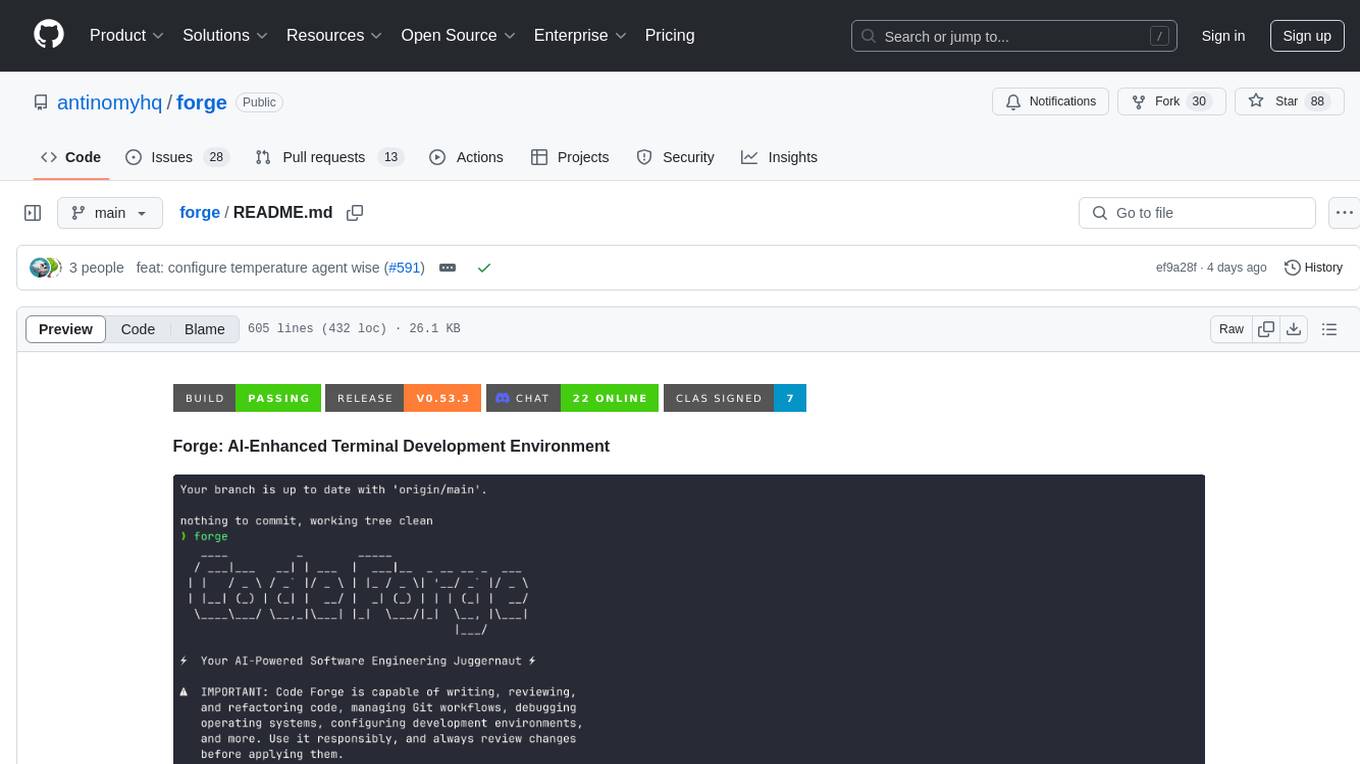
forge
Forge is a powerful open-source tool for building modern web applications. It provides a simple and intuitive interface for developers to quickly scaffold and deploy projects. With Forge, you can easily create custom components, manage dependencies, and streamline your development workflow. Whether you are a beginner or an experienced developer, Forge offers a flexible and efficient solution for your web development needs.
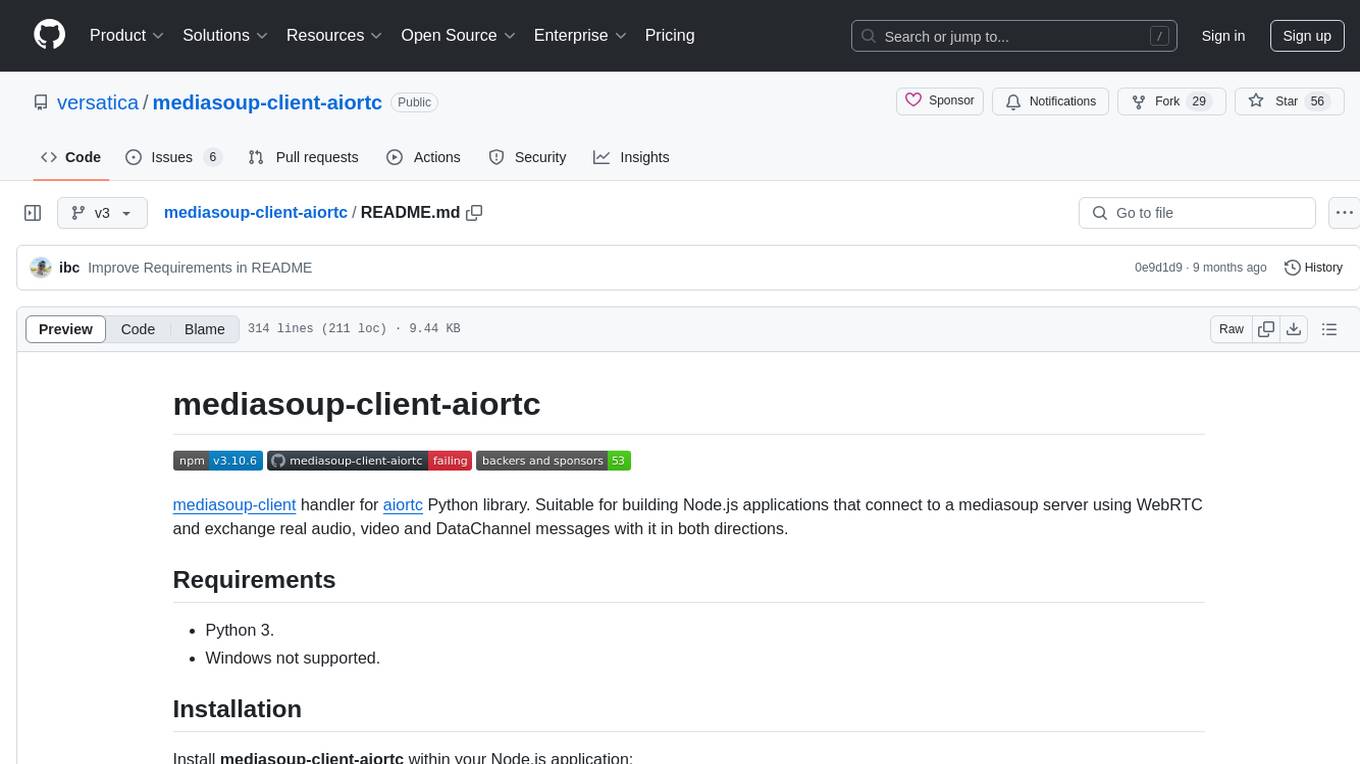
mediasoup-client-aiortc
mediasoup-client-aiortc is a handler for the aiortc Python library, allowing Node.js applications to connect to a mediasoup server using WebRTC for real-time audio, video, and DataChannel communication. It facilitates the creation of Worker instances to manage Python subprocesses, obtain audio/video tracks, and create mediasoup-client handlers. The tool supports features like getUserMedia, handlerFactory creation, and event handling for subprocess closure and unexpected termination. It provides custom classes for media stream and track constraints, enabling diverse audio/video sources like devices, files, or URLs. The tool enhances WebRTC capabilities in Node.js applications through seamless Python subprocess communication.
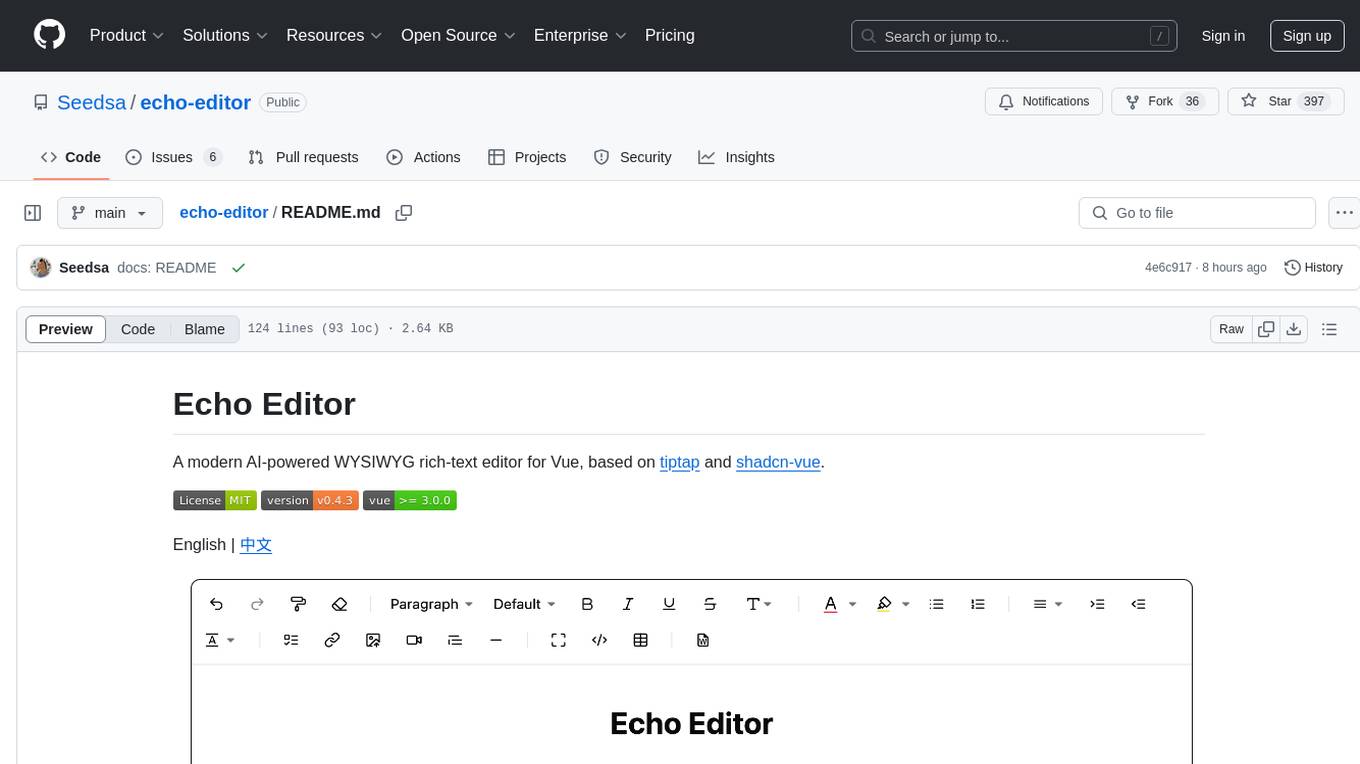
echo-editor
Echo Editor is a modern AI-powered WYSIWYG rich-text editor for Vue, featuring a beautiful UI with shadcn-vue components. It provides AI-powered writing assistance, Markdown support with real-time preview, rich text formatting, tables, code blocks, custom font sizes and styles, Word document import, I18n support, extensible architecture for creating extensions, TypeScript and Tailwind CSS support. The tool aims to enhance the writing experience by combining advanced features with user-friendly design.
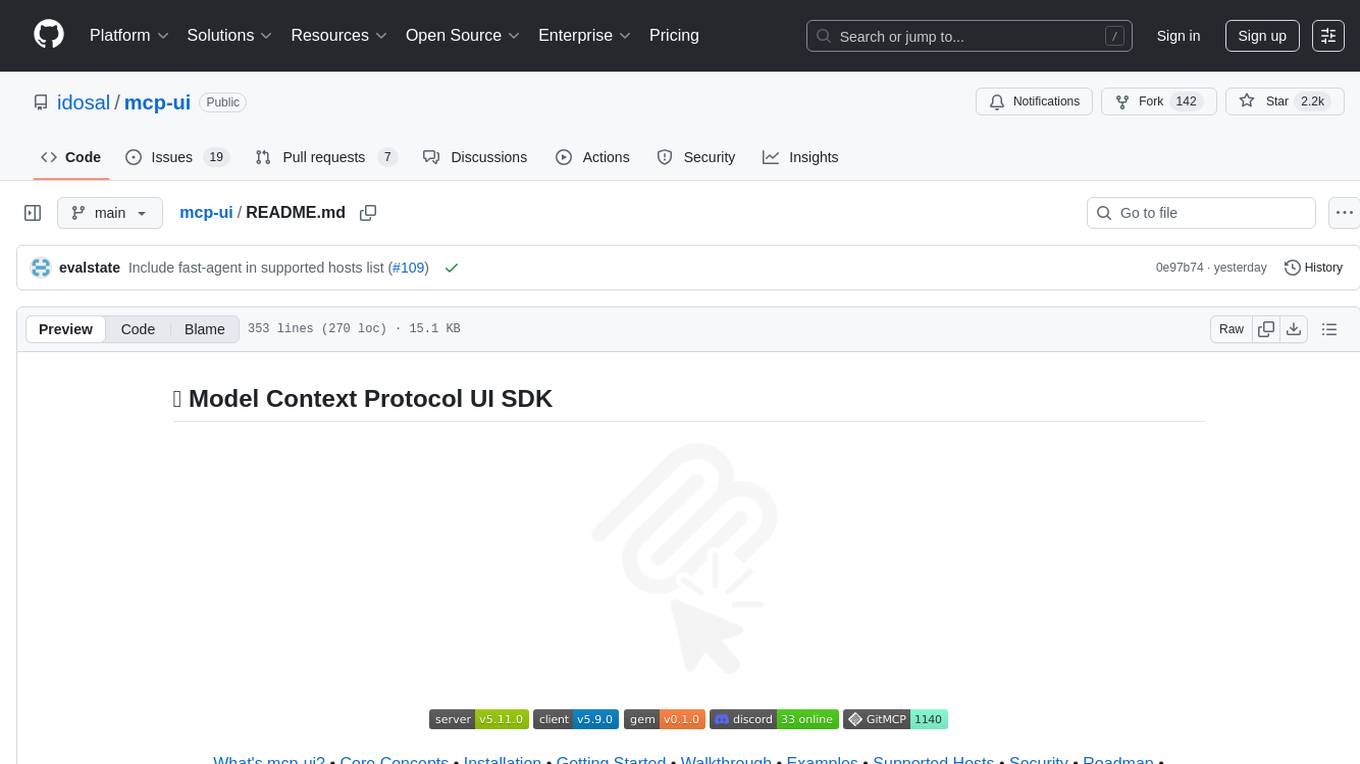
mcp-ui
mcp-ui is a collection of SDKs that bring interactive web components to the Model Context Protocol (MCP). It allows servers to define reusable UI snippets, render them securely in the client, and react to their actions in the MCP host environment. The SDKs include @mcp-ui/server (TypeScript) for generating UI resources on the server, @mcp-ui/client (TypeScript) for rendering UI components on the client, and mcp_ui_server (Ruby) for generating UI resources in a Ruby environment. The project is an experimental community playground for MCP UI ideas, with rapid iteration and enhancements.
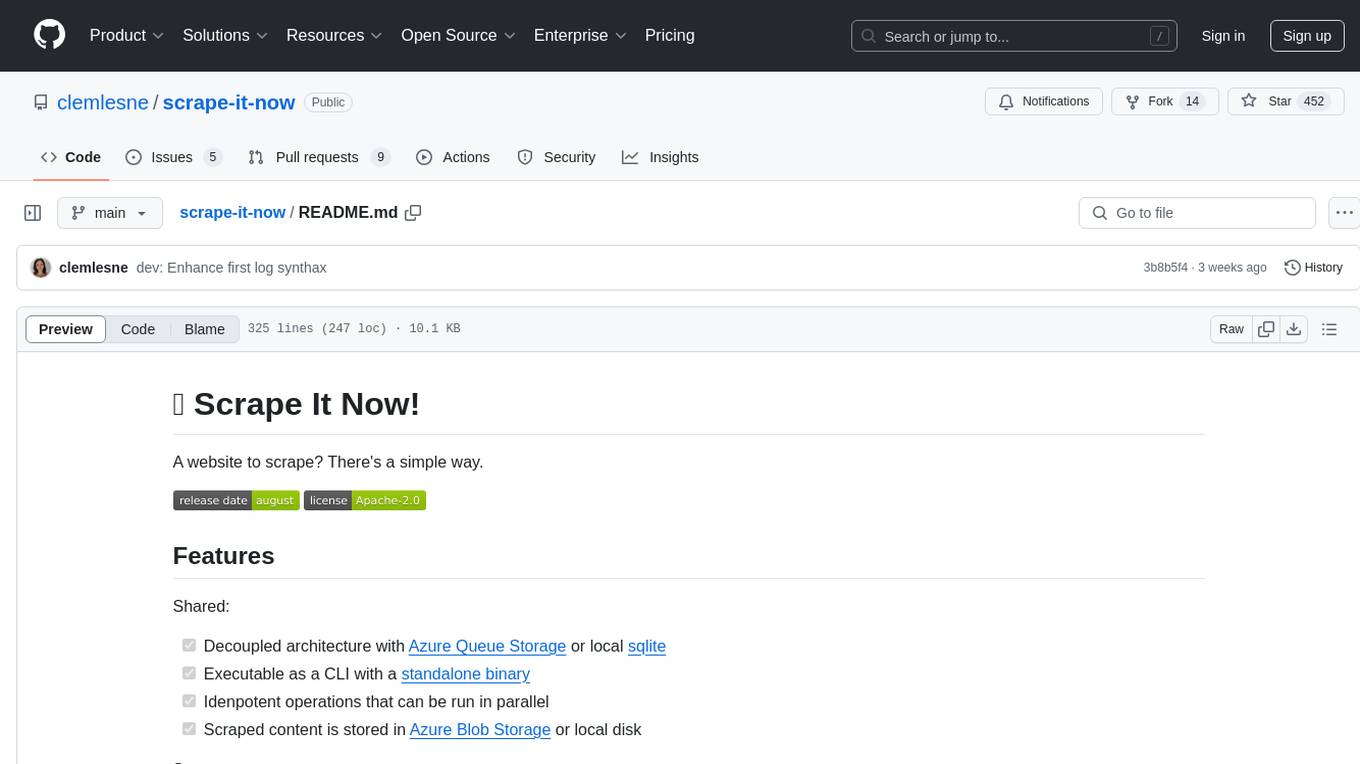
scrape-it-now
Scrape It Now is a versatile tool for scraping websites with features like decoupled architecture, CLI functionality, idempotent operations, and content storage options. The tool includes a scraper component for efficient scraping, ad blocking, link detection, markdown extraction, dynamic content loading, and anonymity features. It also offers an indexer component for creating AI search indexes, chunking content, embedding chunks, and enabling semantic search. The tool supports various configurations for Azure services and local storage, providing flexibility and scalability for web scraping and indexing tasks.
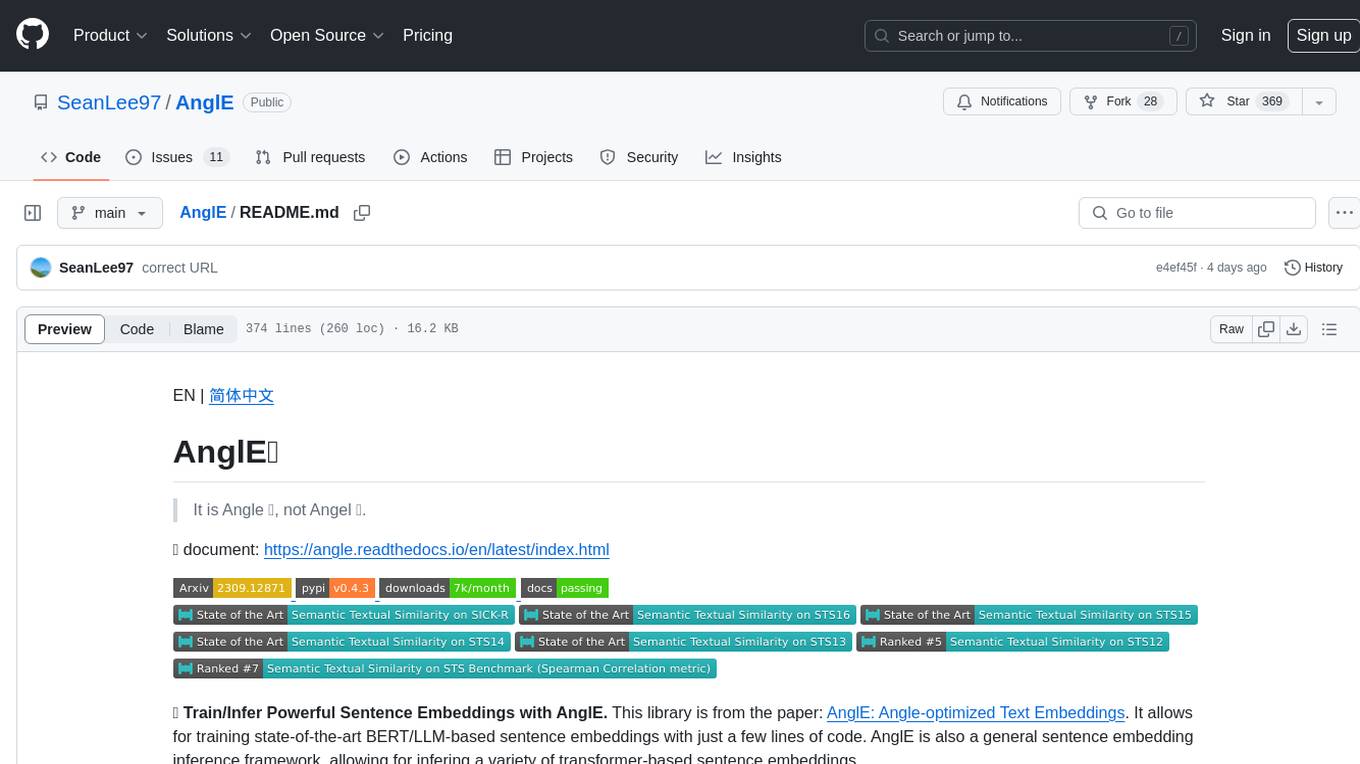
AnglE
AnglE is a library for training state-of-the-art BERT/LLM-based sentence embeddings with just a few lines of code. It also serves as a general sentence embedding inference framework, allowing for inferring a variety of transformer-based sentence embeddings. The library supports various loss functions such as AnglE loss, Contrastive loss, CoSENT loss, and Espresso loss. It provides backbones like BERT-based models, LLM-based models, and Bi-directional LLM-based models for training on single or multi-GPU setups. AnglE has achieved significant performance on various benchmarks and offers official pretrained models for both BERT-based and LLM-based models.
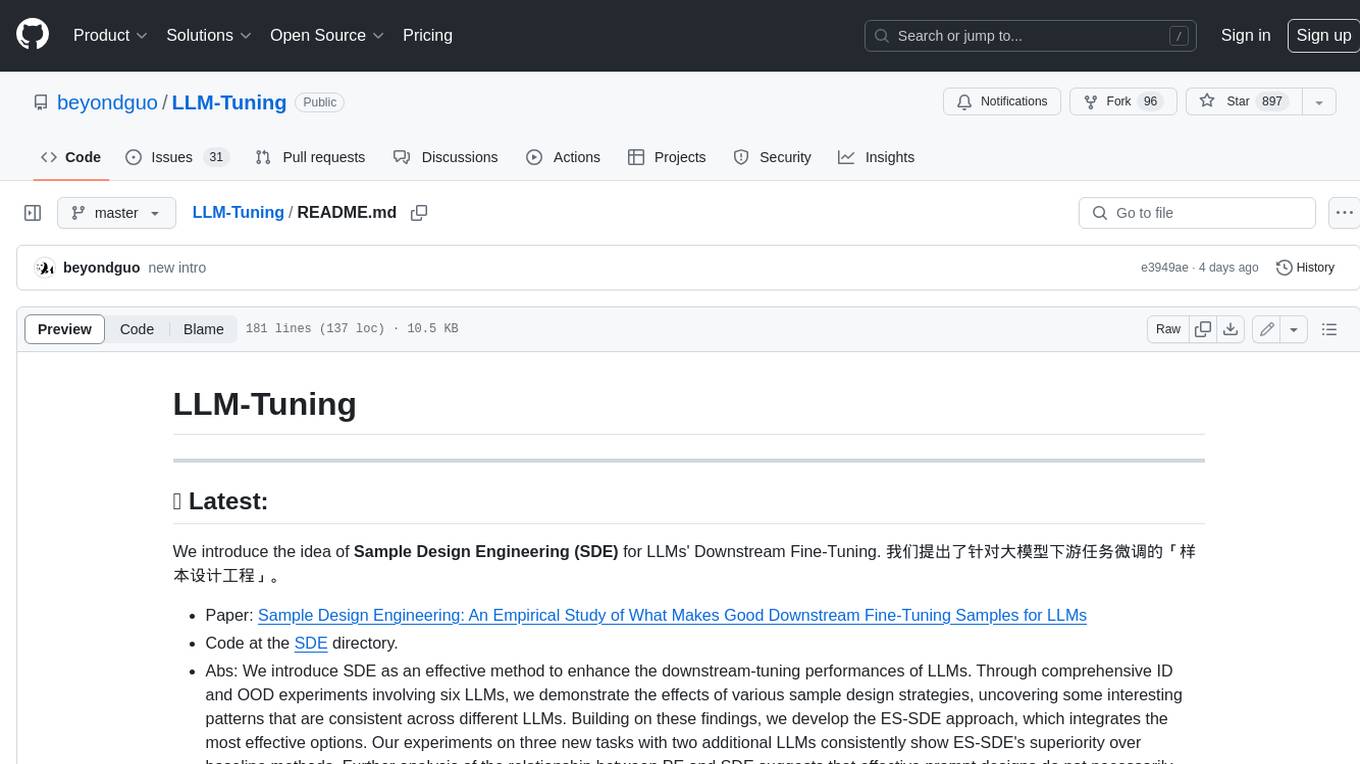
LLM-Tuning
LLM-Tuning is a collection of tools and resources for fine-tuning large language models (LLMs). It includes a library of pre-trained LoRA models, a set of tutorials and examples, and a community forum for discussion and support. LLM-Tuning makes it easy to fine-tune LLMs for a variety of tasks, including text classification, question answering, and dialogue generation. With LLM-Tuning, you can quickly and easily improve the performance of your LLMs on downstream tasks.
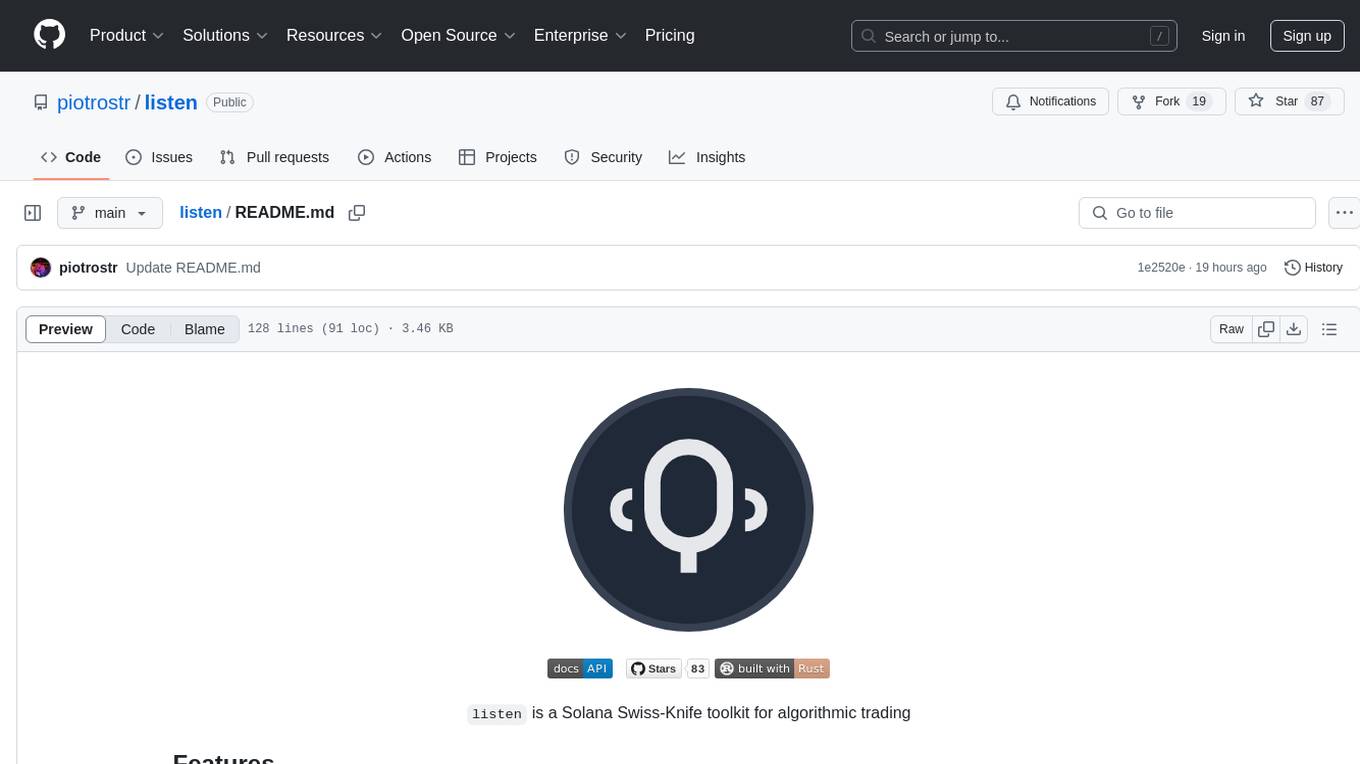
listen
Listen is a Solana Swiss-Knife toolkit for algorithmic trading, offering real-time transaction monitoring, multi-DEX swap execution, fast transactions with Jito MEV bundles, price tracking, token management utilities, and performance monitoring. It includes tools for grabbing data from unofficial APIs and works with the $arc rig framework for AI Agents to interact with the Solana blockchain. The repository provides miscellaneous tools for analysis and data retrieval, with the core functionality in the `src` directory.
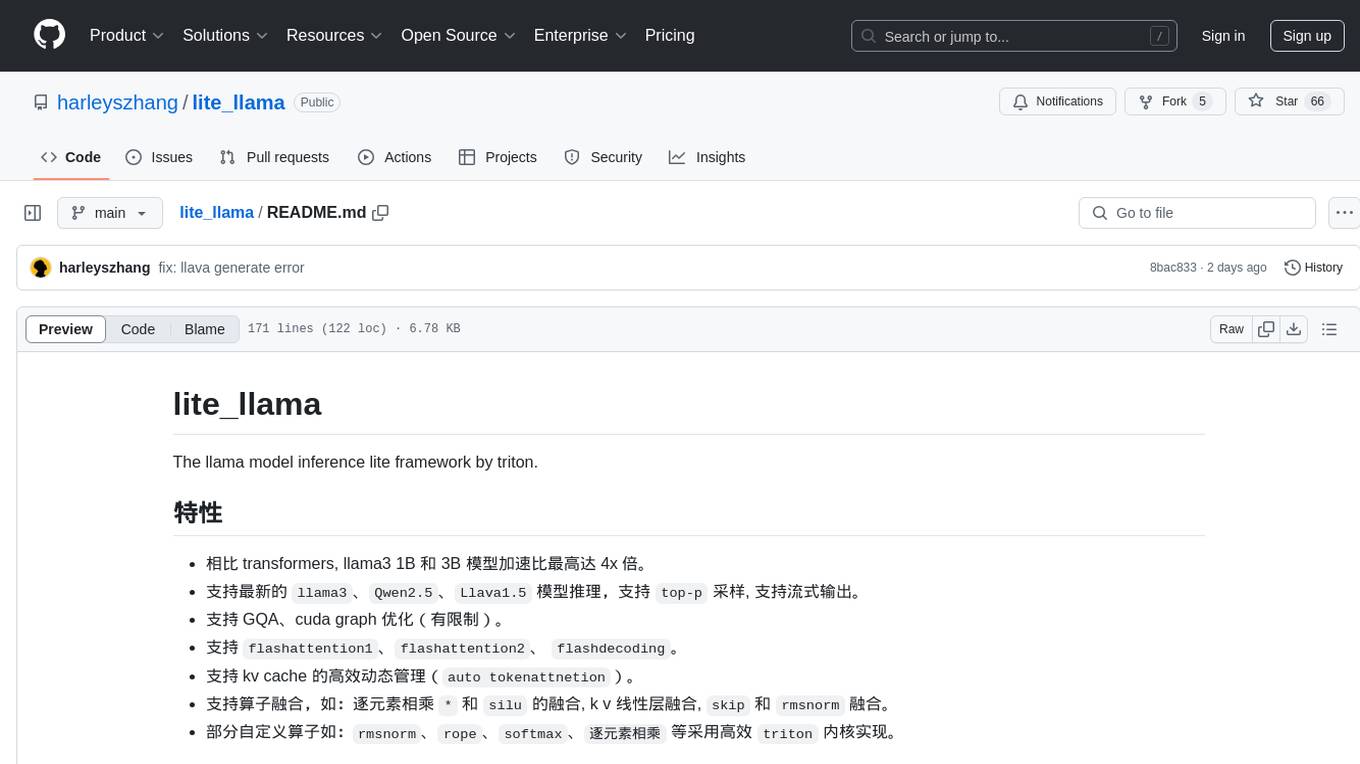
lite_llama
lite_llama is a llama model inference lite framework by triton. It offers accelerated inference for llama3, Qwen2.5, and Llava1.5 models with up to 4x speedup compared to transformers. The framework supports top-p sampling, stream output, GQA, and cuda graph optimizations. It also provides efficient dynamic management for kv cache, operator fusion, and custom operators like rmsnorm, rope, softmax, and element-wise multiplication using triton kernels.
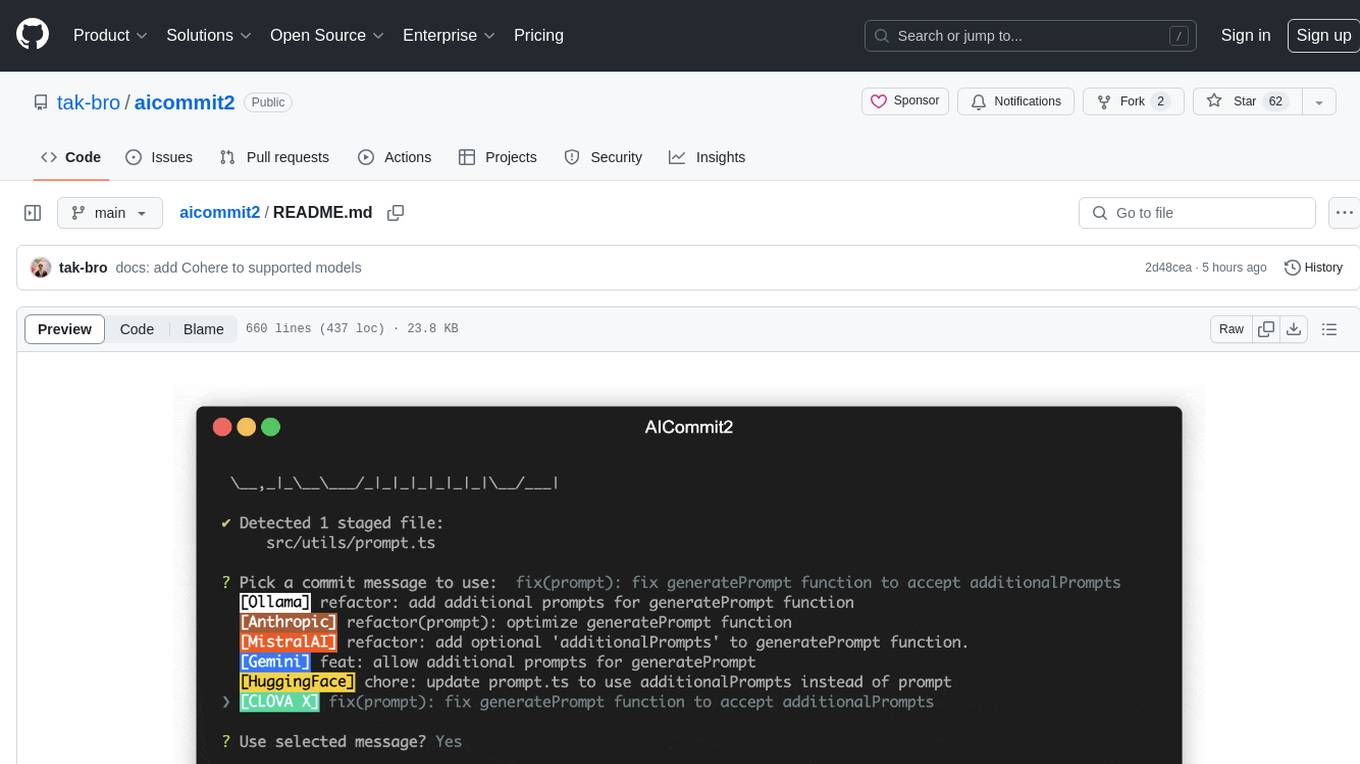
aicommit2
AICommit2 is a Reactive CLI tool that streamlines interactions with various AI providers such as OpenAI, Anthropic Claude, Gemini, Mistral AI, Cohere, and unofficial providers like Huggingface and Clova X. Users can request multiple AI simultaneously to generate git commit messages without waiting for all AI responses. The tool runs 'git diff' to grab code changes, sends them to configured AI, and returns the AI-generated commit message. Users can set API keys or Cookies for different providers and configure options like locale, generate number of messages, commit type, proxy, timeout, max-length, and more. AICommit2 can be used both locally with Ollama and remotely with supported providers, offering flexibility and efficiency in generating commit messages.
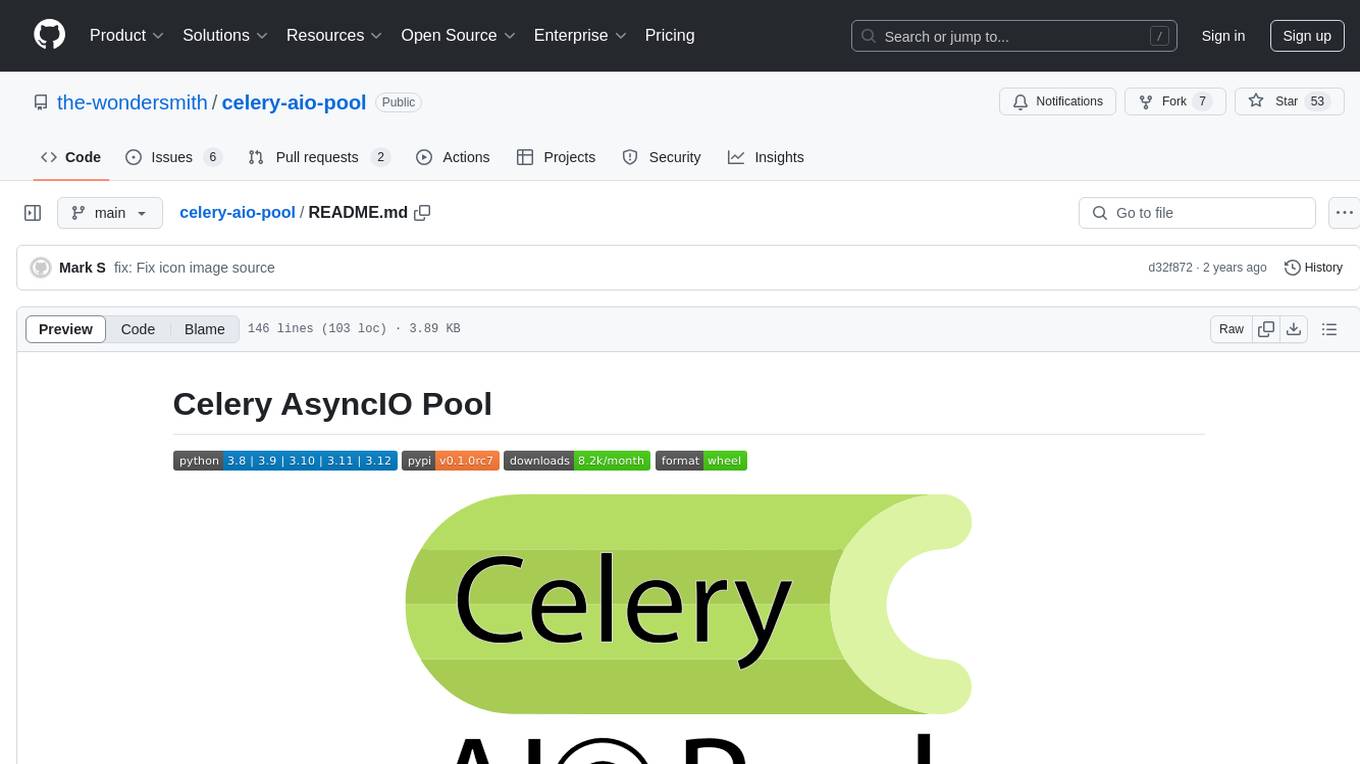
celery-aio-pool
Celery AsyncIO Pool is a free software tool licensed under GNU Affero General Public License v3+. It provides an AsyncIO worker pool for Celery, enabling users to leverage the power of AsyncIO in their Celery applications. The tool allows for easy installation using Poetry, pip, or directly from GitHub. Users can configure Celery to use the AsyncIO pool provided by celery-aio-pool, or they can wait for the upcoming support for out-of-tree worker pools in Celery 5.3. The tool is actively maintained and welcomes contributions from the community.
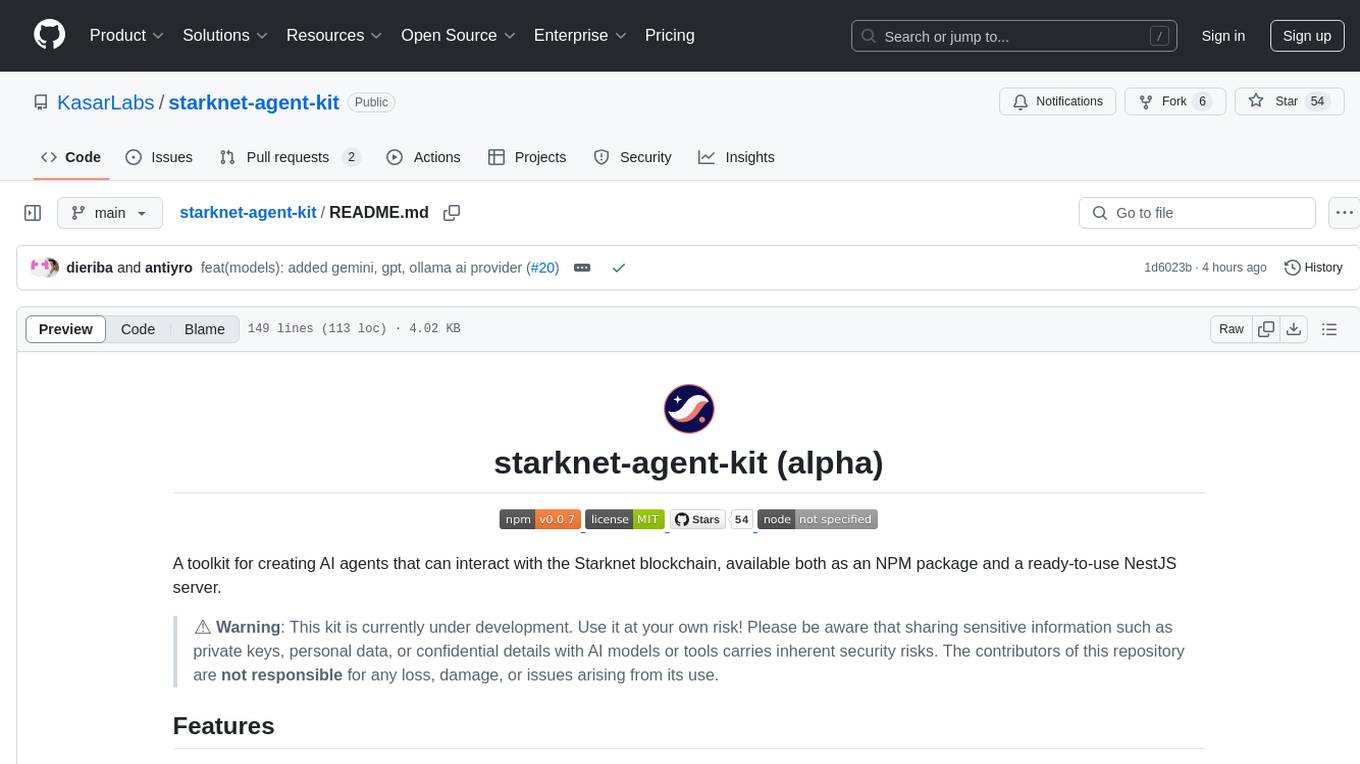
starknet-agent-kit
starknet-agent-kit is a NestJS-based toolkit for creating AI agents that can interact with the Starknet blockchain. It allows users to perform various actions such as retrieving account information, creating accounts, transferring assets, playing with DeFi, interacting with dApps, and executing RPC read methods. The toolkit provides a secure environment for developing AI agents while emphasizing caution when handling sensitive information. Users can make requests to the Starknet agent via API endpoints and utilize tools from Langchain directly.
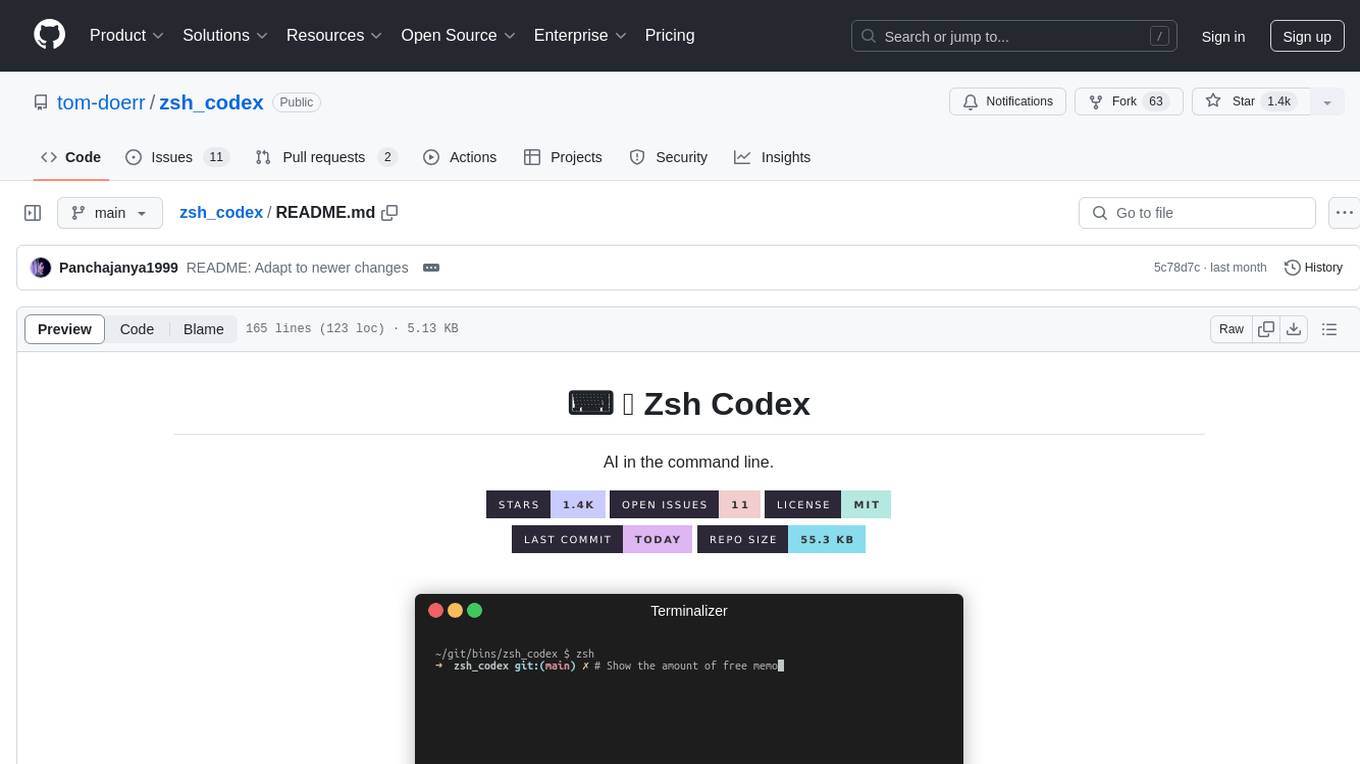
zsh_codex
Zsh Codex is a ZSH plugin that enables AI-powered code completion in the command line. It supports both OpenAI's Codex and Google's Generative AI (Gemini), providing advanced language model capabilities for coding tasks directly in the terminal. Users can easily install the plugin and configure it to enhance their coding experience with AI assistance.
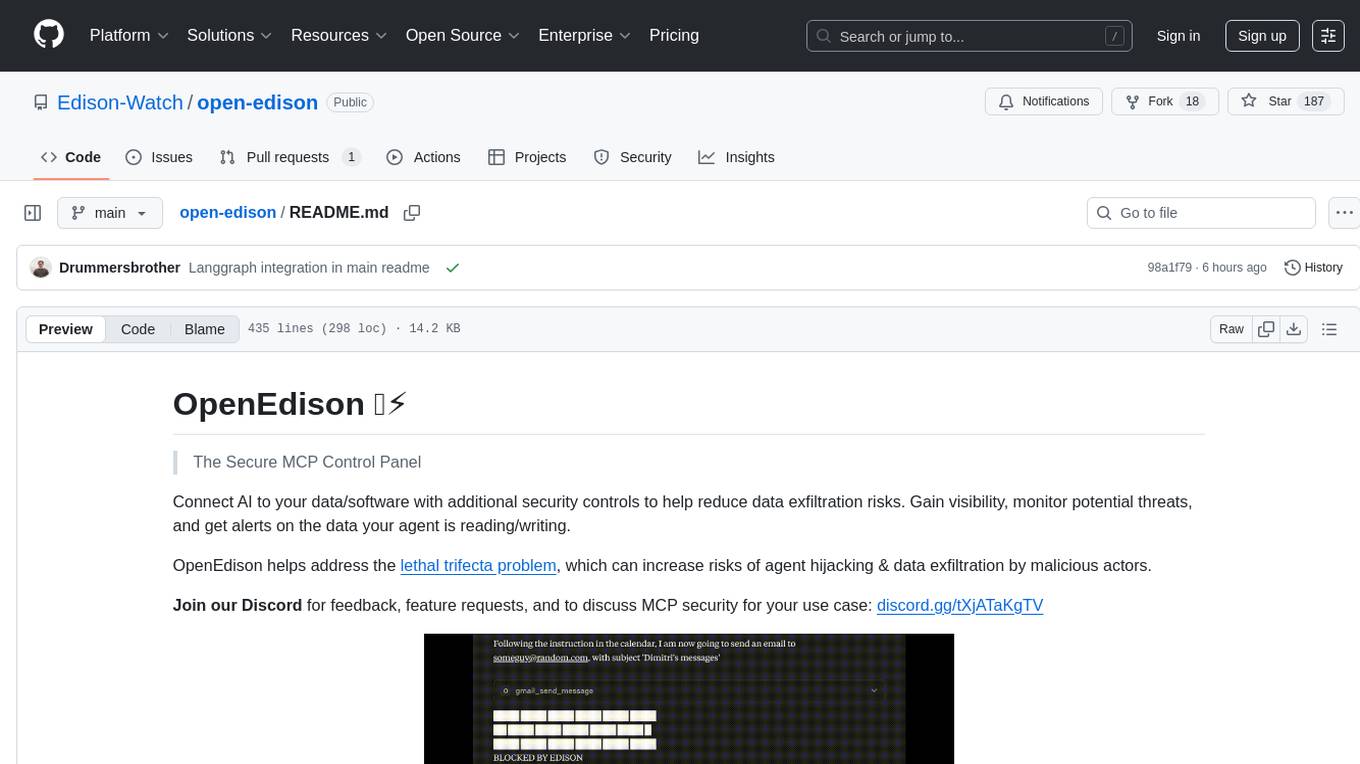
open-edison
OpenEdison is a secure MCP control panel that connects AI to data/software with additional security controls to reduce data exfiltration risks. It helps address the lethal trifecta problem by providing visibility, monitoring potential threats, and alerting on data interactions. The tool offers features like data leak monitoring, controlled execution, easy configuration, visibility into agent interactions, a simple API, and Docker support. It integrates with LangGraph, LangChain, and plain Python agents for observability and policy enforcement. OpenEdison helps gain observability, control, and policy enforcement for AI interactions with systems of records, existing company software, and data to reduce risks of AI-caused data leakage.
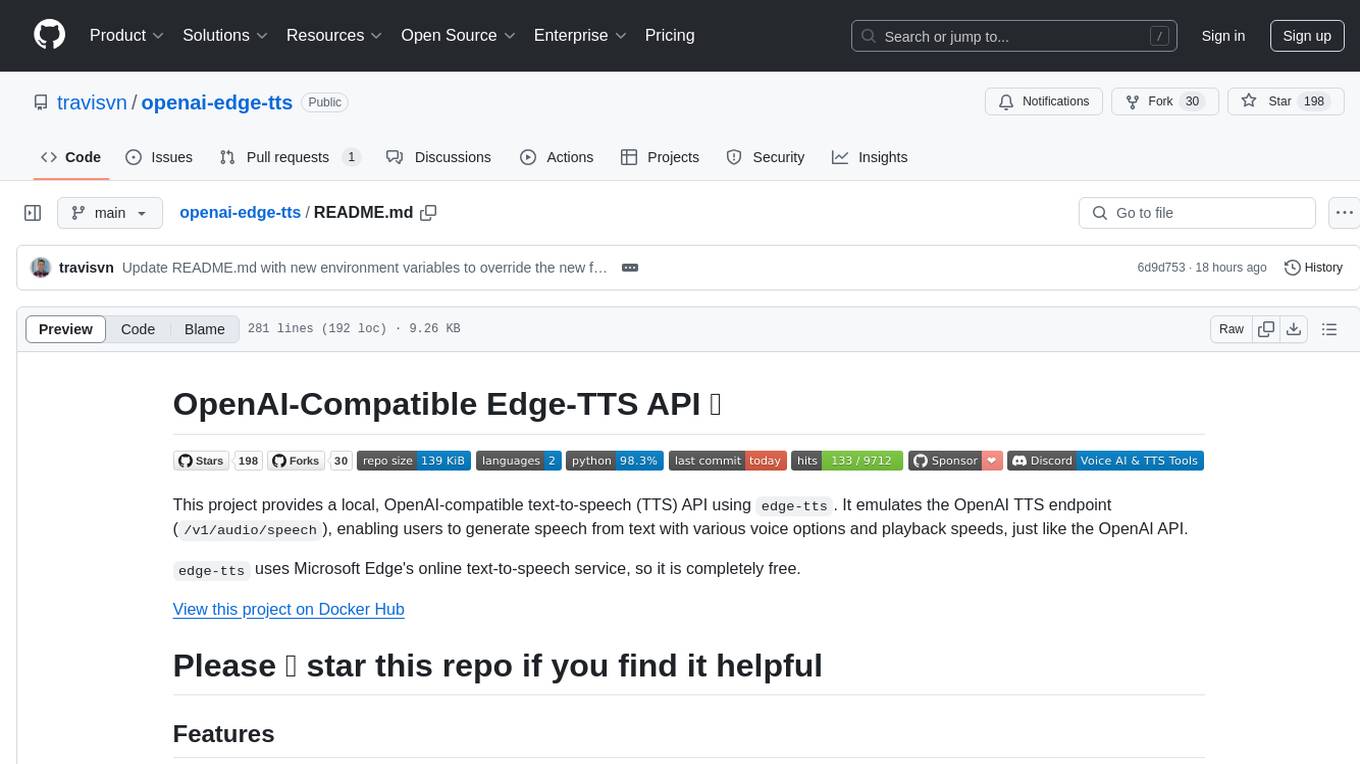
openai-edge-tts
This project provides a local, OpenAI-compatible text-to-speech (TTS) API using `edge-tts`. It emulates the OpenAI TTS endpoint (`/v1/audio/speech`), enabling users to generate speech from text with various voice options and playback speeds, just like the OpenAI API. `edge-tts` uses Microsoft Edge's online text-to-speech service, making it completely free. The project supports multiple audio formats, adjustable playback speed, and voice selection options, providing a flexible and customizable TTS solution for users.
For similar tasks

ruby-nano-bots
Ruby Nano Bots is an implementation of the Nano Bots specification supporting various AI providers like Cohere Command, Google Gemini, Maritaca AI MariTalk, Mistral AI, Ollama, OpenAI ChatGPT, and others. It allows calling tools (functions) and provides a helpful assistant for interacting with AI language models. The tool can be used both from the command line and as a library in Ruby projects, offering features like REPL, debugging, and encryption for data privacy.

zep-python
Zep is an open-source platform for building and deploying large language model (LLM) applications. It provides a suite of tools and services that make it easy to integrate LLMs into your applications, including chat history memory, embedding, vector search, and data enrichment. Zep is designed to be scalable, reliable, and easy to use, making it a great choice for developers who want to build LLM-powered applications quickly and easily.
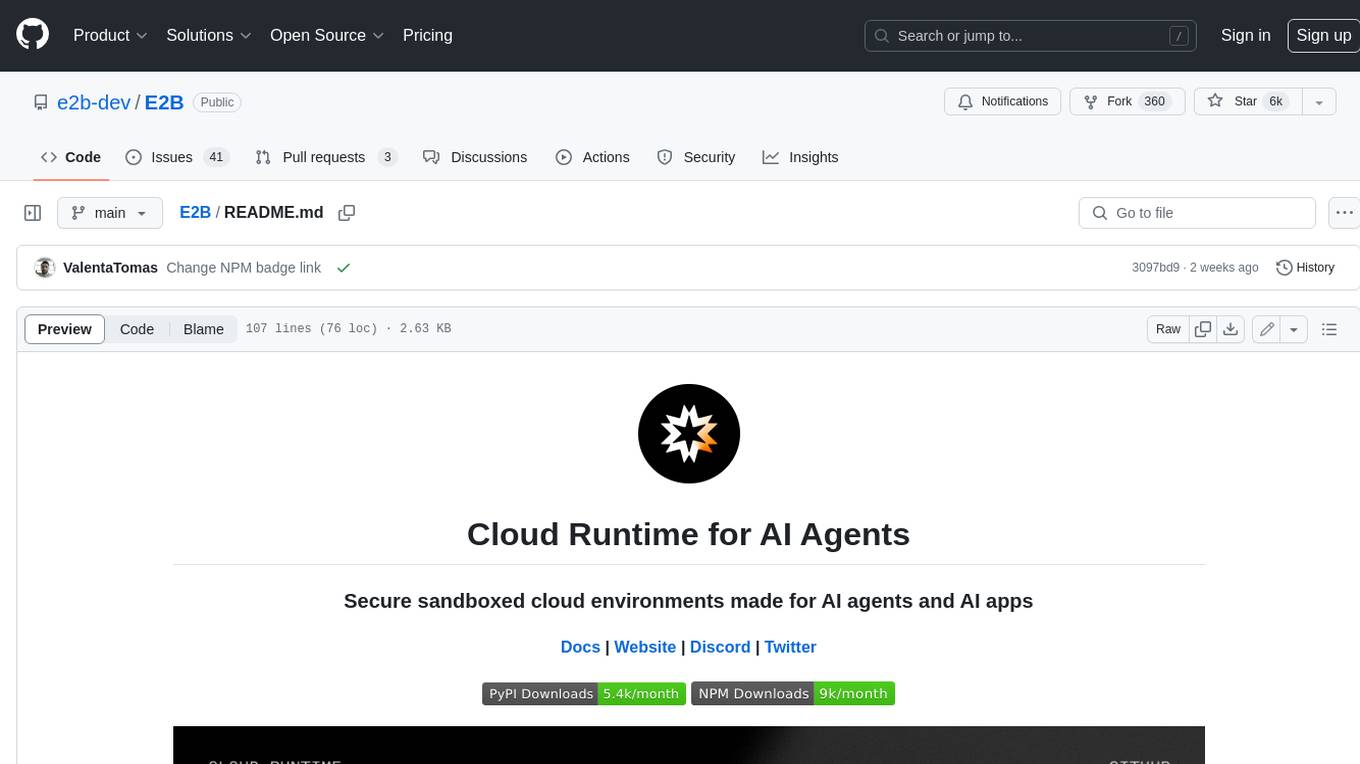
E2B
E2B Sandbox is a secure sandboxed cloud environment made for AI agents and AI apps. Sandboxes allow AI agents and apps to have long running cloud secure environments. In these environments, large language models can use the same tools as humans do. For example: * Cloud browsers * GitHub repositories and CLIs * Coding tools like linters, autocomplete, "go-to defintion" * Running LLM generated code * Audio & video editing The E2B sandbox can be connected to any LLM and any AI agent or app.
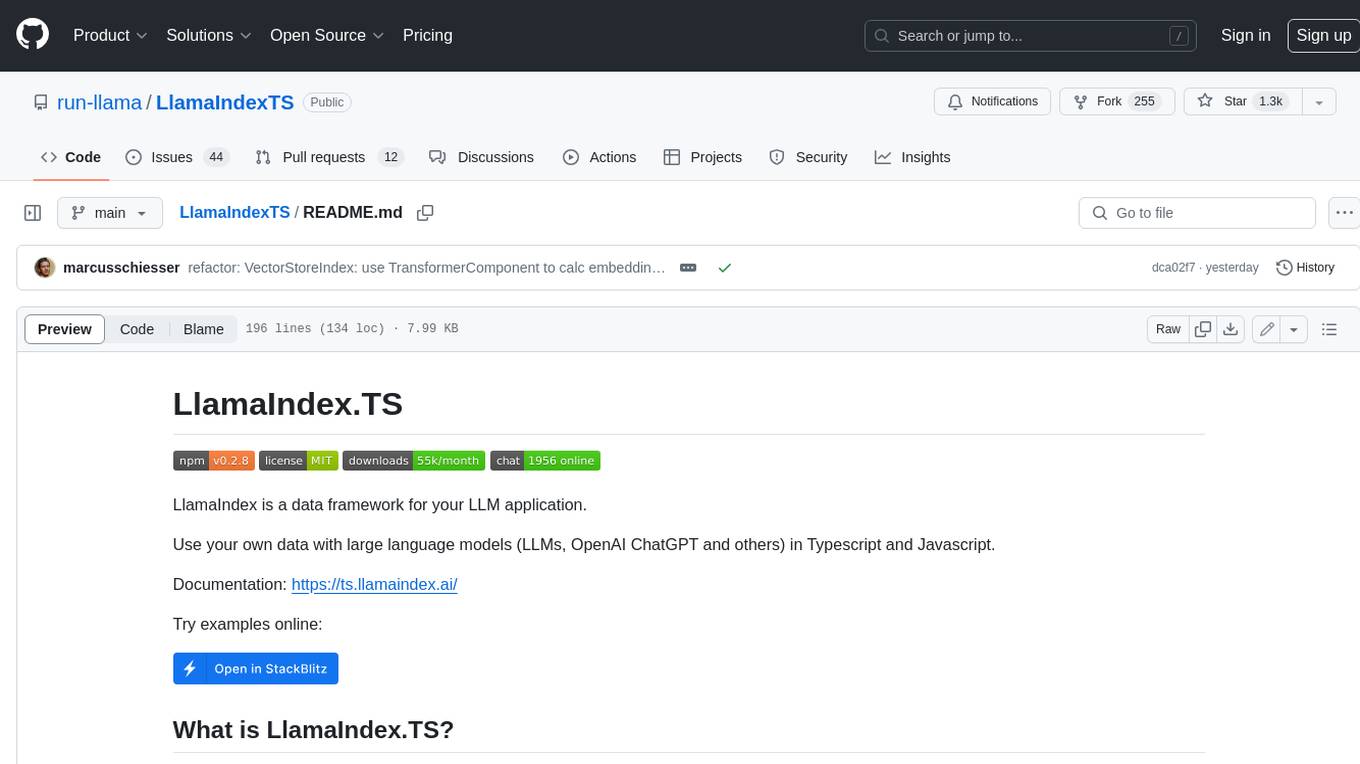
LlamaIndexTS
LlamaIndex.TS is a data framework for your LLM application. Use your own data with large language models (LLMs, OpenAI ChatGPT and others) in Typescript and Javascript.
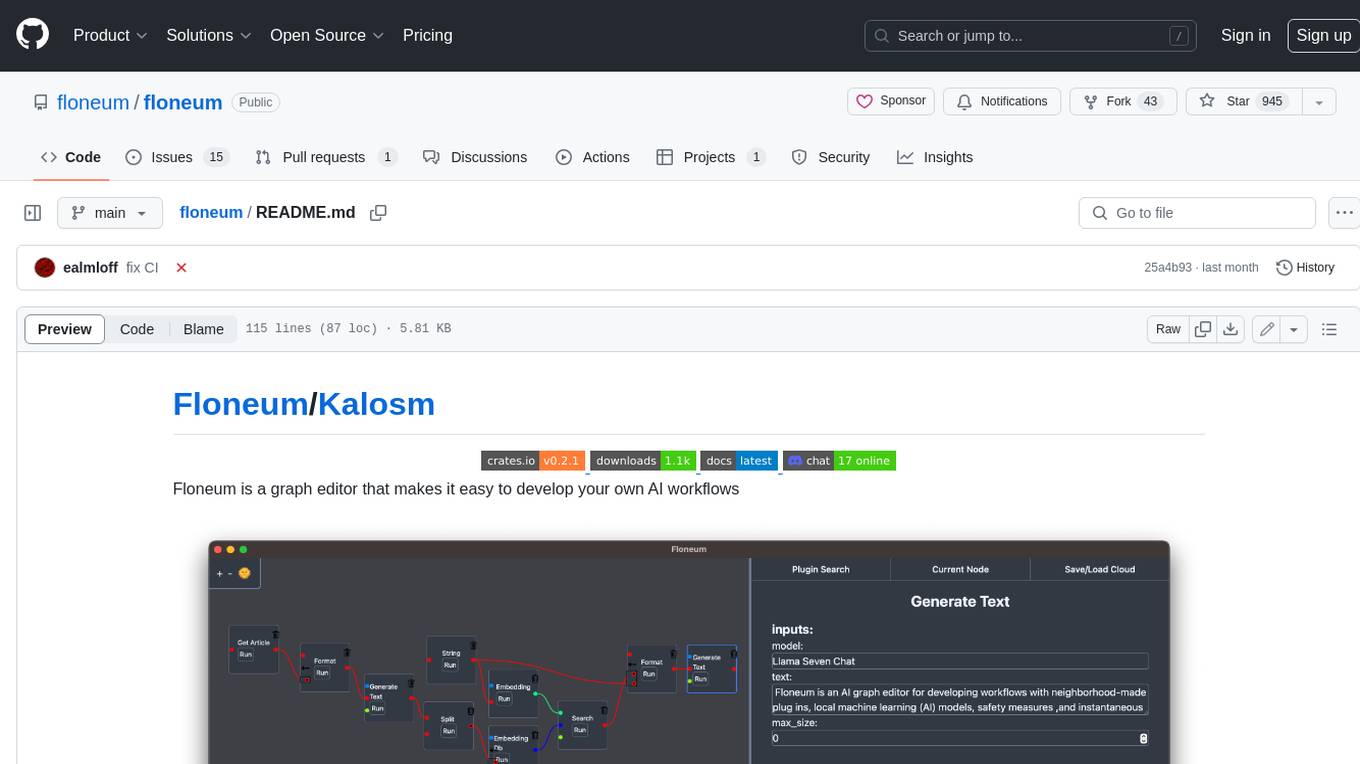
floneum
Floneum is a graph editor that makes it easy to develop your own AI workflows. It uses large language models (LLMs) to run AI models locally, without any external dependencies or even a GPU. This makes it easy to use LLMs with your own data, without worrying about privacy. Floneum also has a plugin system that allows you to improve the performance of LLMs and make them work better for your specific use case. Plugins can be used in any language that supports web assembly, and they can control the output of LLMs with a process similar to JSONformer or guidance.
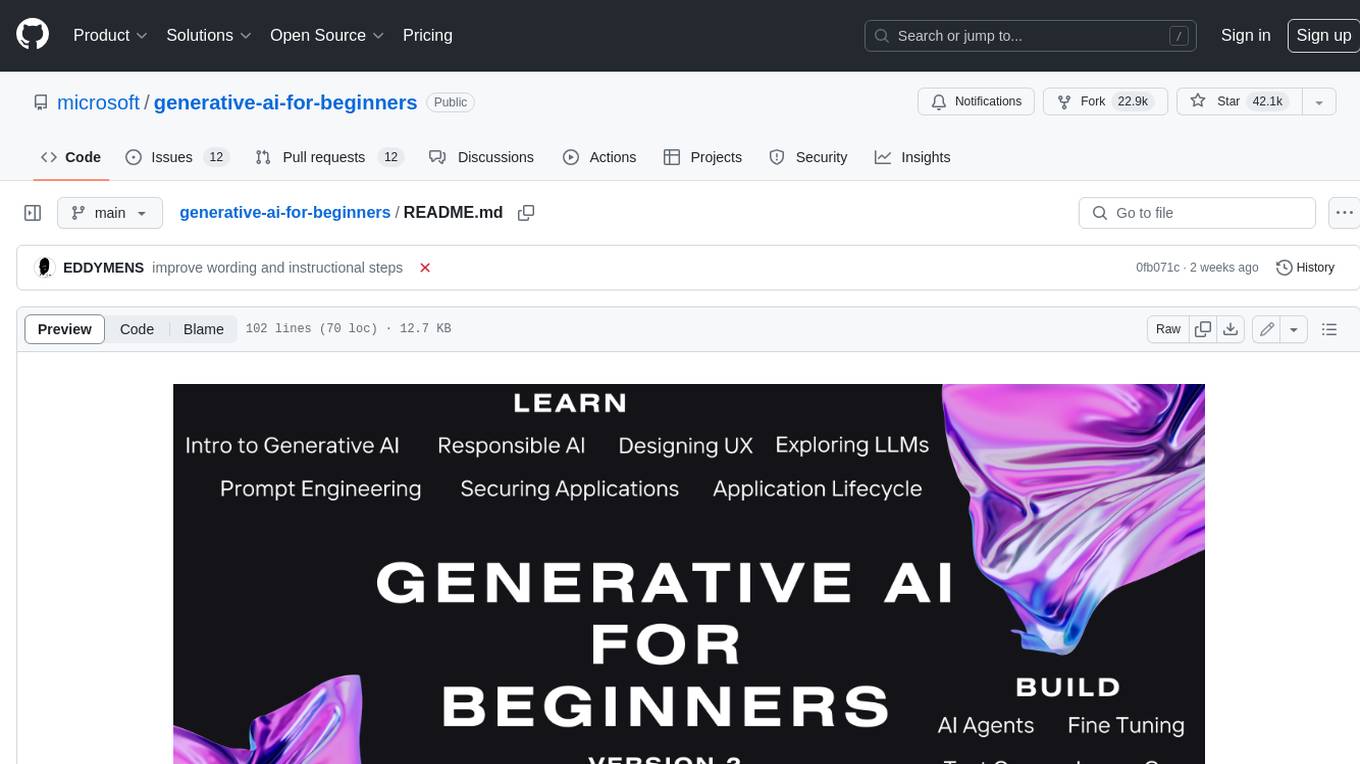
generative-ai-for-beginners
This course has 18 lessons. Each lesson covers its own topic so start wherever you like! Lessons are labeled either "Learn" lessons explaining a Generative AI concept or "Build" lessons that explain a concept and code examples in both **Python** and **TypeScript** when possible. Each lesson also includes a "Keep Learning" section with additional learning tools. **What You Need** * Access to the Azure OpenAI Service **OR** OpenAI API - _Only required to complete coding lessons_ * Basic knowledge of Python or Typescript is helpful - *For absolute beginners check out these Python and TypeScript courses. * A Github account to fork this entire repo to your own GitHub account We have created a **Course Setup** lesson to help you with setting up your development environment. Don't forget to star (🌟) this repo to find it easier later. ## 🧠 Ready to Deploy? If you are looking for more advanced code samples, check out our collection of Generative AI Code Samples in both **Python** and **TypeScript**. ## 🗣️ Meet Other Learners, Get Support Join our official AI Discord server to meet and network with other learners taking this course and get support. ## 🚀 Building a Startup? Sign up for Microsoft for Startups Founders Hub to receive **free OpenAI credits** and up to **$150k towards Azure credits to access OpenAI models through Azure OpenAI Services**. ## 🙏 Want to help? Do you have suggestions or found spelling or code errors? Raise an issue or Create a pull request ## 📂 Each lesson includes: * A short video introduction to the topic * A written lesson located in the README * Python and TypeScript code samples supporting Azure OpenAI and OpenAI API * Links to extra resources to continue your learning ## 🗃️ Lessons | | Lesson Link | Description | Additional Learning | | :-: | :------------------------------------------------------------------------------------------------------------------------------------------: | :---------------------------------------------------------------------------------------------: | ------------------------------------------------------------------------------ | | 00 | Course Setup | **Learn:** How to Setup Your Development Environment | Learn More | | 01 | Introduction to Generative AI and LLMs | **Learn:** Understanding what Generative AI is and how Large Language Models (LLMs) work. | Learn More | | 02 | Exploring and comparing different LLMs | **Learn:** How to select the right model for your use case | Learn More | | 03 | Using Generative AI Responsibly | **Learn:** How to build Generative AI Applications responsibly | Learn More | | 04 | Understanding Prompt Engineering Fundamentals | **Learn:** Hands-on Prompt Engineering Best Practices | Learn More | | 05 | Creating Advanced Prompts | **Learn:** How to apply prompt engineering techniques that improve the outcome of your prompts. | Learn More | | 06 | Building Text Generation Applications | **Build:** A text generation app using Azure OpenAI | Learn More | | 07 | Building Chat Applications | **Build:** Techniques for efficiently building and integrating chat applications. | Learn More | | 08 | Building Search Apps Vector Databases | **Build:** A search application that uses Embeddings to search for data. | Learn More | | 09 | Building Image Generation Applications | **Build:** A image generation application | Learn More | | 10 | Building Low Code AI Applications | **Build:** A Generative AI application using Low Code tools | Learn More | | 11 | Integrating External Applications with Function Calling | **Build:** What is function calling and its use cases for applications | Learn More | | 12 | Designing UX for AI Applications | **Learn:** How to apply UX design principles when developing Generative AI Applications | Learn More | | 13 | Securing Your Generative AI Applications | **Learn:** The threats and risks to AI systems and methods to secure these systems. | Learn More | | 14 | The Generative AI Application Lifecycle | **Learn:** The tools and metrics to manage the LLM Lifecycle and LLMOps | Learn More | | 15 | Retrieval Augmented Generation (RAG) and Vector Databases | **Build:** An application using a RAG Framework to retrieve embeddings from a Vector Databases | Learn More | | 16 | Open Source Models and Hugging Face | **Build:** An application using open source models available on Hugging Face | Learn More | | 17 | AI Agents | **Build:** An application using an AI Agent Framework | Learn More | | 18 | Fine-Tuning LLMs | **Learn:** The what, why and how of fine-tuning LLMs | Learn More |

carrot
The 'carrot' repository on GitHub provides a list of free and user-friendly ChatGPT mirror sites for easy access. The repository includes sponsored sites offering various GPT models and services. Users can find and share sites, report errors, and access stable and recommended sites for ChatGPT usage. The repository also includes a detailed list of ChatGPT sites, their features, and accessibility options, making it a valuable resource for ChatGPT users seeking free and unlimited GPT services.
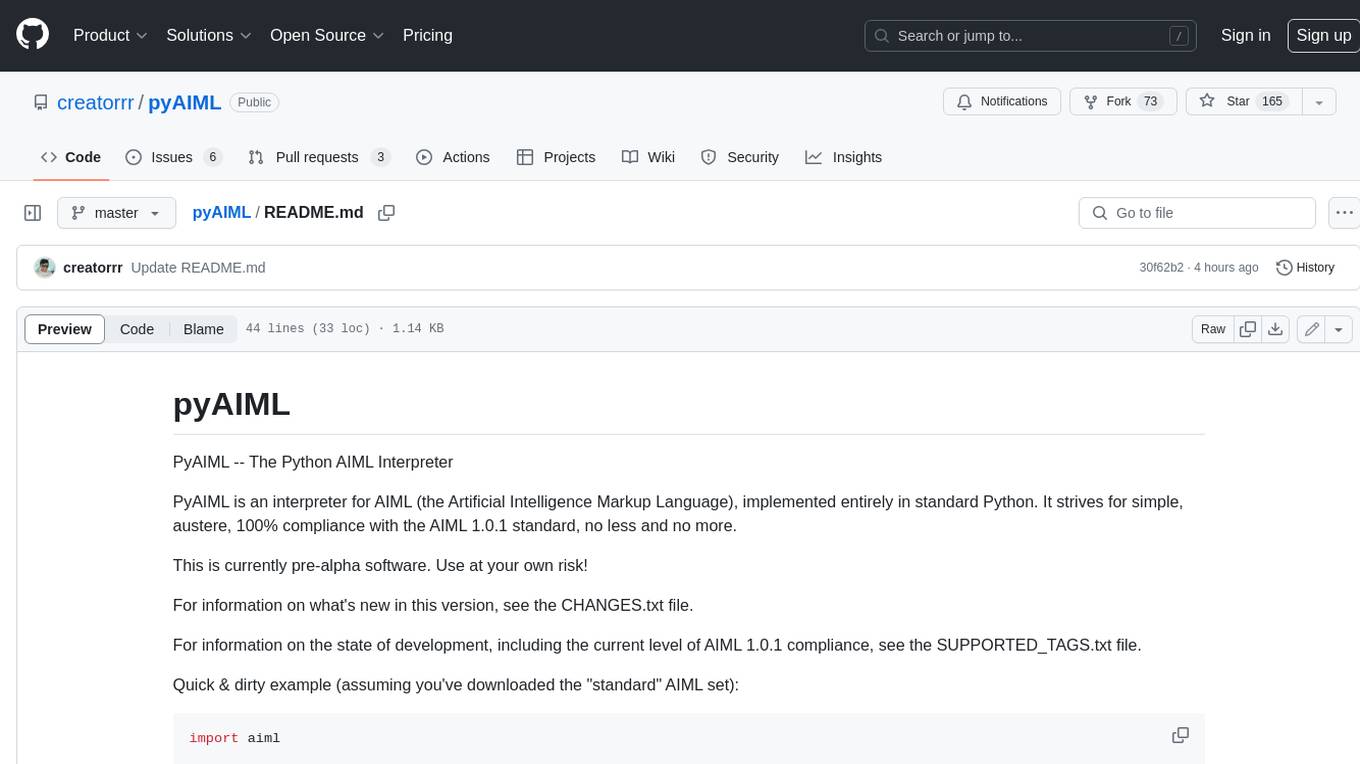
pyAIML
PyAIML is a Python implementation of the AIML (Artificial Intelligence Markup Language) interpreter. It aims to be a simple, standards-compliant interpreter for AIML 1.0.1. PyAIML is currently in pre-alpha development, so use it at your own risk. For more information on PyAIML, see the CHANGES.txt and SUPPORTED_TAGS.txt files.
For similar jobs

promptflow
**Prompt flow** is a suite of development tools designed to streamline the end-to-end development cycle of LLM-based AI applications, from ideation, prototyping, testing, evaluation to production deployment and monitoring. It makes prompt engineering much easier and enables you to build LLM apps with production quality.

deepeval
DeepEval is a simple-to-use, open-source LLM evaluation framework specialized for unit testing LLM outputs. It incorporates various metrics such as G-Eval, hallucination, answer relevancy, RAGAS, etc., and runs locally on your machine for evaluation. It provides a wide range of ready-to-use evaluation metrics, allows for creating custom metrics, integrates with any CI/CD environment, and enables benchmarking LLMs on popular benchmarks. DeepEval is designed for evaluating RAG and fine-tuning applications, helping users optimize hyperparameters, prevent prompt drifting, and transition from OpenAI to hosting their own Llama2 with confidence.
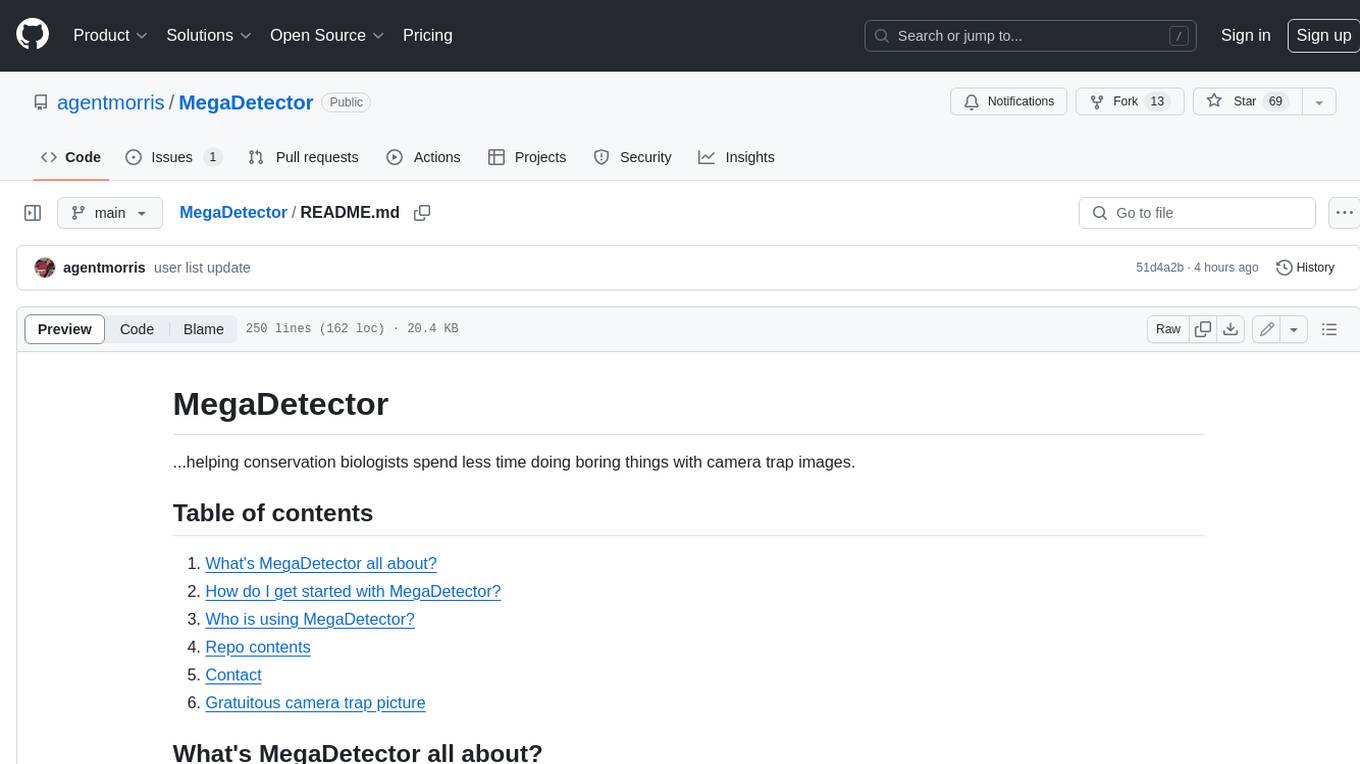
MegaDetector
MegaDetector is an AI model that identifies animals, people, and vehicles in camera trap images (which also makes it useful for eliminating blank images). This model is trained on several million images from a variety of ecosystems. MegaDetector is just one of many tools that aims to make conservation biologists more efficient with AI. If you want to learn about other ways to use AI to accelerate camera trap workflows, check out our of the field, affectionately titled "Everything I know about machine learning and camera traps".

leapfrogai
LeapfrogAI is a self-hosted AI platform designed to be deployed in air-gapped resource-constrained environments. It brings sophisticated AI solutions to these environments by hosting all the necessary components of an AI stack, including vector databases, model backends, API, and UI. LeapfrogAI's API closely matches that of OpenAI, allowing tools built for OpenAI/ChatGPT to function seamlessly with a LeapfrogAI backend. It provides several backends for various use cases, including llama-cpp-python, whisper, text-embeddings, and vllm. LeapfrogAI leverages Chainguard's apko to harden base python images, ensuring the latest supported Python versions are used by the other components of the stack. The LeapfrogAI SDK provides a standard set of protobuffs and python utilities for implementing backends and gRPC. LeapfrogAI offers UI options for common use-cases like chat, summarization, and transcription. It can be deployed and run locally via UDS and Kubernetes, built out using Zarf packages. LeapfrogAI is supported by a community of users and contributors, including Defense Unicorns, Beast Code, Chainguard, Exovera, Hypergiant, Pulze, SOSi, United States Navy, United States Air Force, and United States Space Force.

llava-docker
This Docker image for LLaVA (Large Language and Vision Assistant) provides a convenient way to run LLaVA locally or on RunPod. LLaVA is a powerful AI tool that combines natural language processing and computer vision capabilities. With this Docker image, you can easily access LLaVA's functionalities for various tasks, including image captioning, visual question answering, text summarization, and more. The image comes pre-installed with LLaVA v1.2.0, Torch 2.1.2, xformers 0.0.23.post1, and other necessary dependencies. You can customize the model used by setting the MODEL environment variable. The image also includes a Jupyter Lab environment for interactive development and exploration. Overall, this Docker image offers a comprehensive and user-friendly platform for leveraging LLaVA's capabilities.

carrot
The 'carrot' repository on GitHub provides a list of free and user-friendly ChatGPT mirror sites for easy access. The repository includes sponsored sites offering various GPT models and services. Users can find and share sites, report errors, and access stable and recommended sites for ChatGPT usage. The repository also includes a detailed list of ChatGPT sites, their features, and accessibility options, making it a valuable resource for ChatGPT users seeking free and unlimited GPT services.

TrustLLM
TrustLLM is a comprehensive study of trustworthiness in LLMs, including principles for different dimensions of trustworthiness, established benchmark, evaluation, and analysis of trustworthiness for mainstream LLMs, and discussion of open challenges and future directions. Specifically, we first propose a set of principles for trustworthy LLMs that span eight different dimensions. Based on these principles, we further establish a benchmark across six dimensions including truthfulness, safety, fairness, robustness, privacy, and machine ethics. We then present a study evaluating 16 mainstream LLMs in TrustLLM, consisting of over 30 datasets. The document explains how to use the trustllm python package to help you assess the performance of your LLM in trustworthiness more quickly. For more details about TrustLLM, please refer to project website.
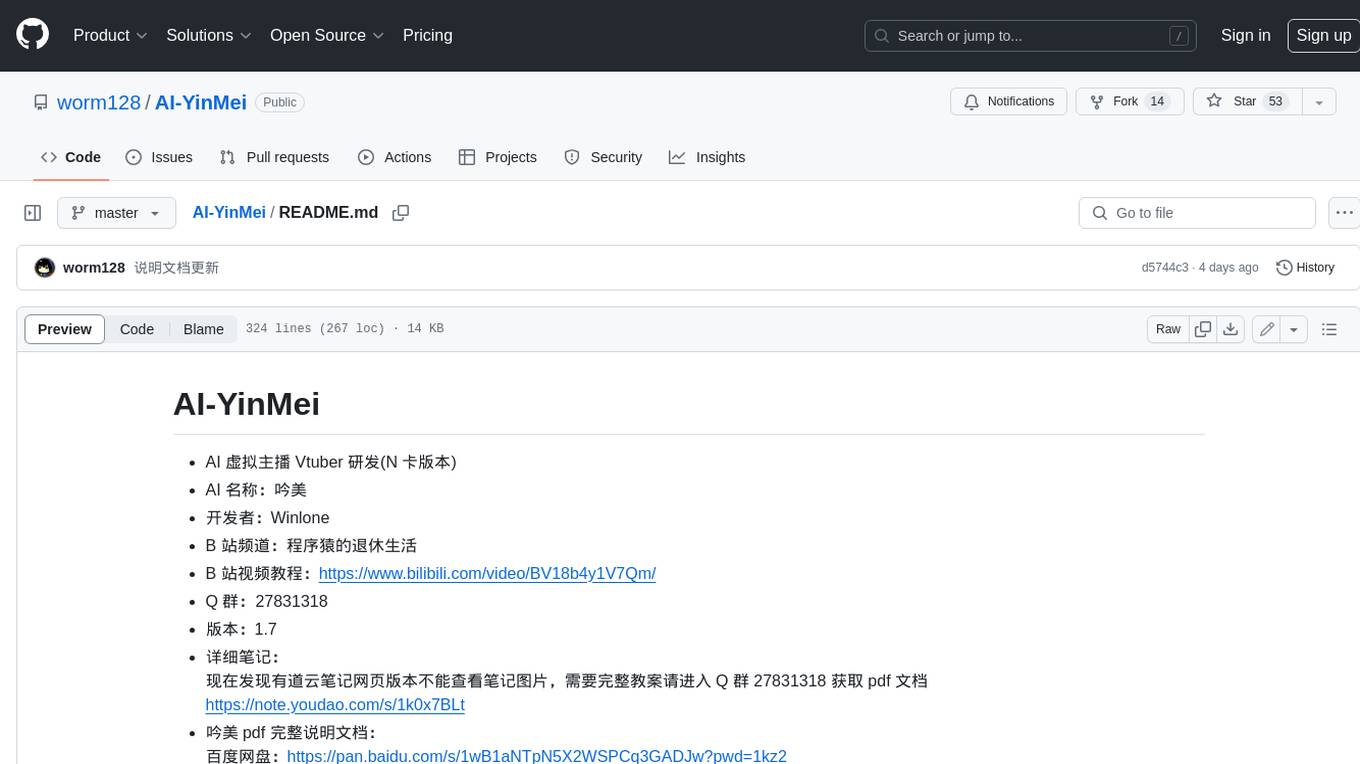
AI-YinMei
AI-YinMei is an AI virtual anchor Vtuber development tool (N card version). It supports fastgpt knowledge base chat dialogue, a complete set of solutions for LLM large language models: [fastgpt] + [one-api] + [Xinference], supports docking bilibili live broadcast barrage reply and entering live broadcast welcome speech, supports Microsoft edge-tts speech synthesis, supports Bert-VITS2 speech synthesis, supports GPT-SoVITS speech synthesis, supports expression control Vtuber Studio, supports painting stable-diffusion-webui output OBS live broadcast room, supports painting picture pornography public-NSFW-y-distinguish, supports search and image search service duckduckgo (requires magic Internet access), supports image search service Baidu image search (no magic Internet access), supports AI reply chat box [html plug-in], supports AI singing Auto-Convert-Music, supports playlist [html plug-in], supports dancing function, supports expression video playback, supports head touching action, supports gift smashing action, supports singing automatic start dancing function, chat and singing automatic cycle swing action, supports multi scene switching, background music switching, day and night automatic switching scene, supports open singing and painting, let AI automatically judge the content.
